Aptian Li-F Granites of the Northern Verkhoyansk–Kolyma Orogenic Belt, Eastern Russia: Composition, Genesis, and Ore Potential
Abstract
1. Introduction
2. Methods
3. Regional Geology
4. Omchikandya Ore Field (Polyarnoe Deposit)
4.1. Geological Setting
4.2. Age of the Studied Rocks
4.3. Petrography and Mineralogy of Granitoids
4.4. Geochemistry of Granitoids
| Sample | 1 | 2 | 3 | 4 | 5 | 6 | 7 | 8 | 9 | 10 | 11 | 12 | I | S | A | C g | C gr |
|---|---|---|---|---|---|---|---|---|---|---|---|---|---|---|---|---|---|
| n | 14 | 6 | 11 | 4 | 18 | 13 | 6 | 16 | 4 | 24 | 12 | 4 | |||||
| SiO2 | 70.41 | 75.92 | 72.90 | 72.33 | 66.53 | 68.27 | 70.73 | 72.05 | 74.22 | 70.45 | 69.59 | 78.78 | 69.2 | 70.3 | 73.8 | ||
| TiO2 | 0.37 | 0.05 | 0.03 | 0.04 | 0.43 | 0.38 | 0.20 | 0.39 | 0.02 | 0.01 | 0.01 | 0.01 | 0.43 | 0.48 | 0.26 | ||
| Al2O3 | 14.70 | 12.92 | 15.5 | 17.5 | 15.68 | 15.63 | 15.20 | 14.33 | 14.32 | 17.14 | 17.02 | 12.50 | 14.3 | 14.1 | 12.4 | ||
| Fe2O3 | 0.61 | 0.17 | 0.21 | 0,72 | 0.60 | 0.61 | 0.88 | 0.67 | 0.34 | 0.33 | 0.23 | 0.13 | 1.04 | 0.56 | 1.24 | ||
| FeO | 2.69 | 1.05 | 1.15 | 2.95 | 3.59 | 2.93 | 1.14 | 2.23 | 0.86 | 0.97 | 1.13 | 0.86 | 2.29 | 2.87 | 1.58 | ||
| MnO | 0.05 | 0.03 | 0.15 | 0.68 | 0.21 | 0.06 | 0.05 | 0.05 | 0.04 | 0.05 | 0.04 | 0.03 | - | - | - | ||
| MgO | 0.70 | 0.09 | 0.08 | 0.04 | 1.63 | 0.90 | 0.34 | 0.67 | 0.05 | 0.06 | 0.03 | 0.01 | 1.42 | 1.42 | 0.20 | ||
| CaO | 1.97 | 0.82 | 0.34 | 0.07 | 3.82 | 3.33 | 0.80 | 1.04 | 0.30 | 0.04 | 0.16 | 0.24 | 3.20 | 2.03 | 0.75 | ||
| Na2O | 3.19 | 2.59 | 4.04 | 0.26 | 3.38 | 3.33 | 4.17 | 3.17 | 4.29 | 4.74 | 4.33 | 1.11 | 3.13 | 2.41 | 4.07 | ||
| K2O | 4.00 | 5.09 | 3.97 | 3.61 | 2.93 | 3.10 | 4.93 | 4.54 | 4.39 | 3.38 | 3.84 | 1.90 | 3.40 | 3.96 | 4.65 | ||
| H2O | 0.12 | 0.06 | 0.09 | 1.32 | 0.10 | 0.08 | 0.27 | 0.22 | 0.30 | 1.76 | 1.10 | 2.35 | |||||
| P2O5 | 0.10 | 0.05 | 0.045 | 0.04 | 0.11 | 0.08 | 0.09 | 0.19 | 0.27 | 1.81 | 1.31 | 1.07 | |||||
| F | 1.19 | 0.56 | 1.02 | 0.02 | 0.73 | 0.62 | 0.86 | 0.62 | 0.52 | 1.13 | 1.03 | 1.51 | |||||
| Cl | 0.12 | 0.13 | 1.20 | 1.80 | 0.07 | 0.07 | 0.05 | 0.08 | 0.05 | ||||||||
| Total | 100.22 | 99.53 | 100.82 | 101.38 | 99.81 | 99.39 | 99.62 | 100.25 | 99.97 | 101.87 | 99.92 | 100.50 | |||||
| B | 12 | 31 | 47 | 40 | 13.4 | 19 | 24.6 | 74 | 60 | 26.5 | 195 | 420 | 37 | 26 | |||
| Li | 56 | 49 | 1213 | 952 | 42.9 | 40.1 | 61.1 | 88.6 | 65.3 | 1822 | 1708 | 1867 | 151 | 217 | 169 | 180 | 120 |
| Rb | 247 | 157 | 658 | 954 | 109 | 104 | 118 | 147 | 333 | 1260 | 1710 | 1795 | 247 | 120 | 48 | 150 | 440 |
| Sr | 220 | 75 | 40 | 25 | 600 | 506 | 300 | 230 | 213 | 111 | 346 | 437 | 538 | 468 | 352 | 650 | 560 |
| Ba | 510 | 150 | 36 | 23 | 873 | 860 | 560 | 640 | 543 | 99 | 235 | 220 | 21 | 20 | |||
| Nb | 23 | 35 | 63 | 45 | 12 | 11 | 24 | 12.1 | 12.4 | 148 | 226 | 200 | 3.6 | 2.8 | |||
| Ta | 4.3 | 4.8 | 112 | 78 | 1.7 | 1.1 | 1 | 1.9 | 2.5 | 27 | 33.3 | 22 | |||||
| Sc | 8.4 | 6.2 | 44 | 3.0 | 1.9 | ||||||||||||
| Sn | 6.5 | 9.8 | 37 | 170 | 2.4 | 3.2 | 2 | 6.3 | 7.8 | 79 | 41.5 | 6750 | 2.2 | 1.6 | |||
| W | 2.5 | 5.5 | 68 | 76 | 3.2 | 2.2 | 2.5 | 4.3 | 12.5 | 13.6 | 19 | 22 | 19 | 15 | |||
| Pb | 30 | 50 | 32 | 95 | 21.6 | 10 | 25 | 24.5 | 13 | 17 | 21 | 39.55 | 39 | 59 | |||
| Zn | 37 | 28 | 370 | 116 | 54.7 | 37 | 13 | 71.3 | 25 | 75 | 210 | 270 | 1.6 | 1.8 | |||
| As | 16.8 | 81.5 | 32 | 64.4 | 4.5 | 2.8 | 1.8 | 12.5 | 10.9 | 49 | 160 | 76.5 | 0.2 | 0.2 | |||
| Sb | 0.2 | - | 73 | 4.9 | 5.3 | 5.1 | 6.4 | 5.5 | 3.6 | 15 | 24.8 | 76 | 2.7 | 2.8 | |||
| Au | 5.7 | 3.6 | 25.5 | 7.7 | 8.5 | 4.9 | 4.9 | 16.6 | 13.6 | 7 | 6.5 | 25.6 | 180 | 140 | |||
| Zr | 108 | 220 | 107 | 118 | 210 | 206 | 527 | 235 | 117 | 89 | 130 | 90 | |||||
| Y | 18 | - | 35 | 126 | 36.5 | 36.3 | 19.7 | 23 | 10.1 | <1 | 3.5 | 20 | |||||
| Yb | 0.8 | - | 3.1 | 12.3 | 3.8 | 3.4 | 18 | 2.2 | 1.3 | <1 | <1 | 1.6 | 187 | 151 | 229 | ||
| K/Rb | 223 | 247 | 50 | 223 | 247 | 346 | 256 | 132 | 22 | 19 | - | - | 2.1 | ||||
| Rb/Sr | 0.18 | 0.21 | 16.4 | 0.18 | 0.21 | 0.39 | 0.64 | 1.56 | 11.35 | 4.94 | 0.61 | 1.81 | 3.52 | ||||
| Ba/Rb | 8.0 | 8.3 | 0.05 | 8.0 | 8.3 | 4.70 | 4.4 | 1.63 | 0.08 | 0.02 | 0.42 | 0.52 | 0.43 | ||||
| K/(Na + K) | 0.36 | 0.40 | 0.44 | 0.36 | 0.40 | 0.44 | 0.49 | 0.40 | 0.32 | 0.37 | 0.33 | 0.22 | 0.12 | ||||
| Ca/(Na + K) | 0.40 | 0.34 | 0.06 | 0.40 | 0.34 | 0.06 | 0.09 | 0.05 | 0.003 | 0.013 | 0.62 | 0.58 | 0.95 | ||||
| (Na + K)/Al | 0.56 | 0.57 | 0.80 | 0.56 | 0.57 | 0.80 | 0.71 | 0.82 | 0.67 | 0.66 | 0.96 | 1.18 | 0.95 | ||||
| Al/ (2Ca + Na + K) | 1.00 | 1.05 | 1.11 | 1.00 | 1.05 | 1.11 | 1.20 | 1.15 | 1.48 | 1.47 | |||||||
| Sample | 13 | 14 | 15 | 16 | 17 | 18 | 19 | I | S | A | C g | C gr | |||||
| n | 7 | 6 | 10 | 7 | 16 | 6 | 3 | ||||||||||
| SiO2 | 66.53 | 70.72 | 72.68 | 73.18 | 71.91 | 71.21 | 81.63 | 69.2 | 70.3 | 73.8 | |||||||
| TiO2 | 0.66 | 0.26 | 0.21 | 0.12 | 0.08 | 0.06 | 0.01 | 0.43 | 0.48 | 0.26 | |||||||
| Al2O3 | 15.88 | 14.89 | 14.86 | 14.67 | 15.28 | 16.06 | 8.58 | 14.3 | 14.1 | 12.4 | |||||||
| Fe2O3 | 0.68 | 0.48 | 0.36 | 0.07 | 0.19 | 0.17 | 0.04 | 1.04 | 0.56 | 1.24 | |||||||
| FeO | 3.23 | 2.28 | 1.46 | 1.15 | 0.61 | 0.66 | 1.5 | 2.29 | 2.87 | 1.58 | |||||||
| MnO | 0.04 | 0.03 | 0.02 | 0.03 | 0.07 | 0.06 | 0.12 | - | - | - | |||||||
| MgO | 1.43 | 0.70 | 0.33 | 0.13 | 0.04 | 0.07 | 1.13 | 1.42 | 1.42 | 0.20 | |||||||
| CaO | 2.90 | 1.58 | 0.67 | 0.71 | 0.34 | 0.38 | 0.01 | 3.20 | 2.03 | 0.75 | |||||||
| Na2O | 3.33 | 3.17 | 3.36 | 3.94 | 4.40 | 4.02 | 0.41 | 3.13 | 2.41 | 4.07 | |||||||
| K2O | 3.90 | 4.48 | 4.60 | 4.43 | 3.59 | 4.82 | 2.36 | 3.40 | 3.96 | 4.65 | |||||||
| H2O | 1.05 | 0.97 | 0.58 | 0.46 | 0.74 | 0.91 | 1.29 | ||||||||||
| P2O5 | 0.23 | 0.24 | 0.35 | 0.43 | 1.42 | 0.76 | 0.24 | ||||||||||
| F | 2.8 | 0.08 | 0.28 | 0.20 | 0.94 | 0.99 | 2.7 | ||||||||||
| Total | 99.88 | 99.88 | 99.76 | 99.52 | 99.61 | 100.23 | 100.02 | ||||||||||
| B | 24.1 | 9.5 | 26 | 21 | 442 | 1031 | 120 | ||||||||||
| Li | 73.3 | 65.6 | 148 | 150 | 1822 | 1400 | 3040 | 37 | 26 | ||||||||
| Rb | 185 | 192 | 294 | 310 | 1651 | 1140 | 1793 | 151 | 217 | 169 | 180 | 120 | |||||
| Sr | 600 | 501 | 226 | 43 | 24 | 31 | 50 | 247 | 120 | 48 | 150 | 440 | |||||
| Ba | 950 | 914 | 475 | 133 | 155 | 186 | 72 | 538 | 468 | 352 | 650 | 560 | |||||
| Nb | 4.33 | 6.4 | 10 | 13 | 122 | 127 | 180 | 21 | 20 | ||||||||
| Ta | 1.67 | 1.1 | 1.9 | 2.5 | 58 | 36 | 190 | 3.6 | 2.8 | ||||||||
| Sc | |||||||||||||||||
| Sn | 3 | 2.2 | 8.6 | 1.4 | 155 | 91 | 34 | 3.0 | 1.9 | ||||||||
| W | 3 | 2.2 | 6.7 | 5 | 30.5 | 22.5 | 36.1 | 2.2 | 1.6 | ||||||||
| Pb | 21.6 | 21.6 | 24.5 | 17 | 3.7 | 3.1 | 5 | 19 | 15 | ||||||||
| Zn | 54.7 | 54.7 | 71.3 | 4 | 138 | 85 | 270 | 39 | 59 | ||||||||
| As | 14.5 | 1.1 | 1.1 | 2.2 | 6.2 | 20.4 | 26.3 | 1.6 | 1.8 | ||||||||
| Sb | 1.1 | 2.8 | 3.2 | 0.35 | 15 | 11.1 | 9.1 | 0.2 | 0.2 | ||||||||
| Au | 13.4 | 66 | 11 | 10.4 | 7.6 | 10.8 | 5.4 | 2.7 | 2.8 | ||||||||
| Zr | 214 | 153 | 61.2 | 29 | 35 | 83 | 19.5 | 180 | 140 | ||||||||
| Y | 19 | 13 | 16 | 4.4 | <1 | ||||||||||||
| Yb | 2 | 1.5 | 1.6 | 0.7 | <1 | ||||||||||||
| K/Rb | 175 | 193 | 130 | 119 | 0.09 | 0.13 | 187 | 151 | 229 | ||||||||
| Rb/Sr | 5.1 | 4.8 | 1.6 | 0.43 | 68.8 | 36.8 | - | - | 2.1 | ||||||||
| Ba/Rb | 0.31 | 0.38 | 1.3 | 7.2 | 0.35 | 0.44 | 0.61 | 1.81 | 3.52 | ||||||||
| K/(Na + K) | 0.44 | 0.48 | 0.47 | 0.43 | 0.03 | 0.03 | 0.42 | 0.52 | 0.43 | ||||||||
| Ca/(Na + K) | 0.27 | 0.14 | 0.06 | 0.06 | 0.73 | 0.74 | 0.33 | 0.22 | 0.12 | ||||||||
| (Na + K)/Al | 0.61 | 0.68 | 0.71 | 0.77 | 1.3 | 1.28 | 0.62 | 0.58 | 0.95 | ||||||||
| Al/ (2Ca + Na + K) | 1.06 | 1.15 | 1.26 | 1.22 | 0.91 | 0.86 | 0.96 | 1.18 | 0.95 |
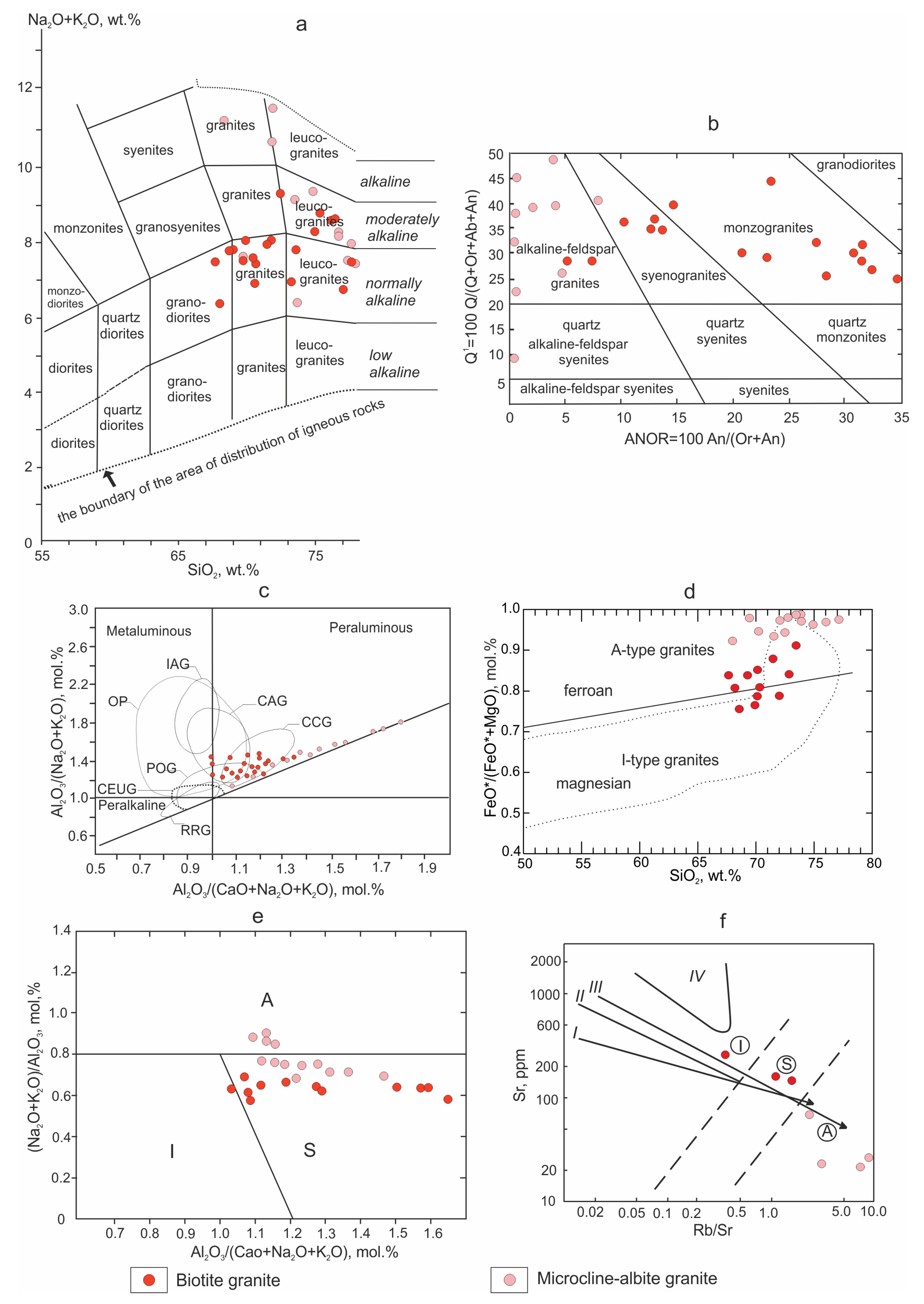

| Sample | 15,896 | 12,192 | 3751 | 37,331 | 602/1 | 602/2 | 2005/1 | 2008/3 | 603/2 | 600/1 |
|---|---|---|---|---|---|---|---|---|---|---|
| No. | 1 | 2 | 3 | 4 | 5 | 6 | 7 | 8 | 9 | 10 |
| Element | ||||||||||
| La | 39 | 12 | 3.7 | 3.4 | 30 | 18 | 24 | 27 | 28 | 2.18 |
| Ce | 61 | 34 | 16 | 23 | 59.2 | 39.1 | 48.7 | 48 | 54 | 0.29 |
| Pr | 26 | 17 | 5.3 | 7.2 | 5.8 | 4.27 | 4.9 | 12 | 8.5 | 0.054 |
| Nd | 27 | 18 | 9.8 | 9 | 20.2 | 16.9 | 18.7 | 29 | 32 | 0.15 |
| Sm | 12 | 7.3 | 5.3 | 5 | 3.8 | 4.11 | 3.94 | 8 | 8 | 0.125 |
| Eu | 0.43 | 0.27 | 0.27 | 0.37 | 0.955 | 0.53 | 0.825 | 0.55 | 0.42 | 0.0126 |
| Gd | 6.7 | 6.1 | 5 | 6 | 3.77 | 4.83 | 4.28 | 7 | 5.8 | 0.12 |
| Tb | 1.2 | 0.68 | 0.8 | 0.87 | 0.51 | 0.81 | 0.6 | 0.96 | 0.87 | 0.02 |
| Dy | 6.2 | 4.6 | 4 | 3.7 | 2.9 | 5.08 | 3.7 | 6 | 5.9 | 0.165 |
| Ho | 1.3 | 1 | 0.89 | 0.96 | 0.62 | 0.99 | 0.74 | 0.98 | 0.97 | 0.026 |
| Er | 6 | 4.30 | 3.5 | 3.3 | 1.81 | 2.88 | 2.44 | 3 | 1 | 0.065 |
| Tm | 1.4 | 0.9 | 0.67 | 0.72 | 0.29 | 0.52 | 0.41 | 1.8 | 1.3 | 0.0086 |
| Yb | 3.7 | 3.9 | 1.5 | 2.2 | 1.94 | 2.95 | 2.31 | 3.6 | 2.7 | 0.077 |
| Lu | - | - | - | - | 0.33 | 0.49 | 0.36 | - | - | 0.0011 |
| T1 | 1.73 | 2.3 | 2.16 | 3.29 | 1.3 | 1.24 | 1.04 | 1.24 | 1.03 | 0.2 |
| T3 | 0.99 | 0.77 | 0.9 | 0.8 | 0.85 | 0.99 | 0.89 | 1.11 | 1.16 | 1.07 |
| T4 | - | - | - | - | 0.84 | 0.91 | 0.91 | - | - | 1 |
| Ti | 1.3 | 1.33 | 1.39 | 1.62 | 0.98 | 1.04 | 0.94 | 1.17 | 1.09 | 0.6 |
| Sample | 601 | K9 | K19 | K6 | K13 | K5 | K17 | K14 | K10 | K21 |
| No. | 11 | 12 | 13 | 14 | 15 | 16 | 17 | 18 | 19 | 20 |
| Element | ||||||||||
| La | 2.35 | 34 | 18 | 2.7 | 3.14 | 1.3 | 3.69 | 1.51 | 2.57 | 1.28 |
| Ce | 0.33 | 73.7 | 47.7 | 13.7 | 2.7 | 0.032 | 3 | 0.26 | 1.61 | 0.39 |
| Pr | 0.043 | 7.6 | 5.5 | 1.64 | 0.33 | 0.0067 | 0.34 | 0.024 | 0.25 | 0.077 |
| Nd | 0.14 | 28 | 21.5 | 6.9 | 1.4 | 0.073 | 1.5 | 0.14 | 1.32 | 0.225 |
| Sm | 0.14 | 5.2 | 5.04 | 1.6 | 0.4 | 0.038 | 0.36 | 0.06 | 0.44 | 0.15 |
| Eu | 0.0096 | 0.36 | 0.45 | 0.28 | 0.084 | 0.0038 | 0.14 | 0.02 | 0.08 | 0.012 |
| Gd | 0.115 | 5.1 | 4.09 | 1.28 | 0.53 | 0.057 | 0.42 | 0.066 | 0.54 | 0.104 |
| Tb | 0.029 | 0.78 | 0.45 | 0.165 | 0.097 | 0.0055 | 0.088 | 0.0075 | 0.07 | 0.021 |
| Dy | 0.14 | 4.51 | 1.88 | 0.68 | 0.68 | 0.034 | 0.63 | 0.11 | 0.4 | 0.19 |
| Ho | 0.024 | 0.93 | 0.34 | 0.15 | 0.16 | 0.0068 | 0.12 | 0.22 | 0.065 | 0.032 |
| Er | 0.084 | 3.1 | 0.96 | 0.35 | 0.44 | 0.016 | 0.4 | 0.083 | 0.18 | 0.063 |
| Tm | 0.0086 | 0.48 | 0.1 | 0.042 | 0.1 | 0.0057 | 0.065 | 0.011 | 0.024 | 0.0068 |
| Yb | 0.09 | 2.97 | 0.94 | 0.35 | 0.62 | 0.021 | 0.52 | 0.043 | 0.16 | 0.035 |
| Lu | 0.0017 | 0.48 | 0.11 | 0.032 | 0.09 | 0.0019 | 0.07 | 0.0048 | 0.02 | 0.0038 |
| T1 | 0.29 | 1.08 | 1.15 | 1.55 | 0.72 | 0.06 | 0.61 | 0.33 | 0.74 | 0.46 |
| T3 | 1.29 | 0.91 | 0.82 | 0.79 | 0.94 | 0.12 | 0.39 | 0.25 | 0.95 | 1.18 |
| T4 | 0.82 | 0.86 | 0.83 | 1 | 1.08 | 1.85 | 0.97 | 0.97 | 0.94 | 0.85 |
| Ti | 0.67 | 0.95 | 0.92 | 1.07 | 0.9 | 0.24 | 0.61 | 0.43 | 0.87 | 0.77 |
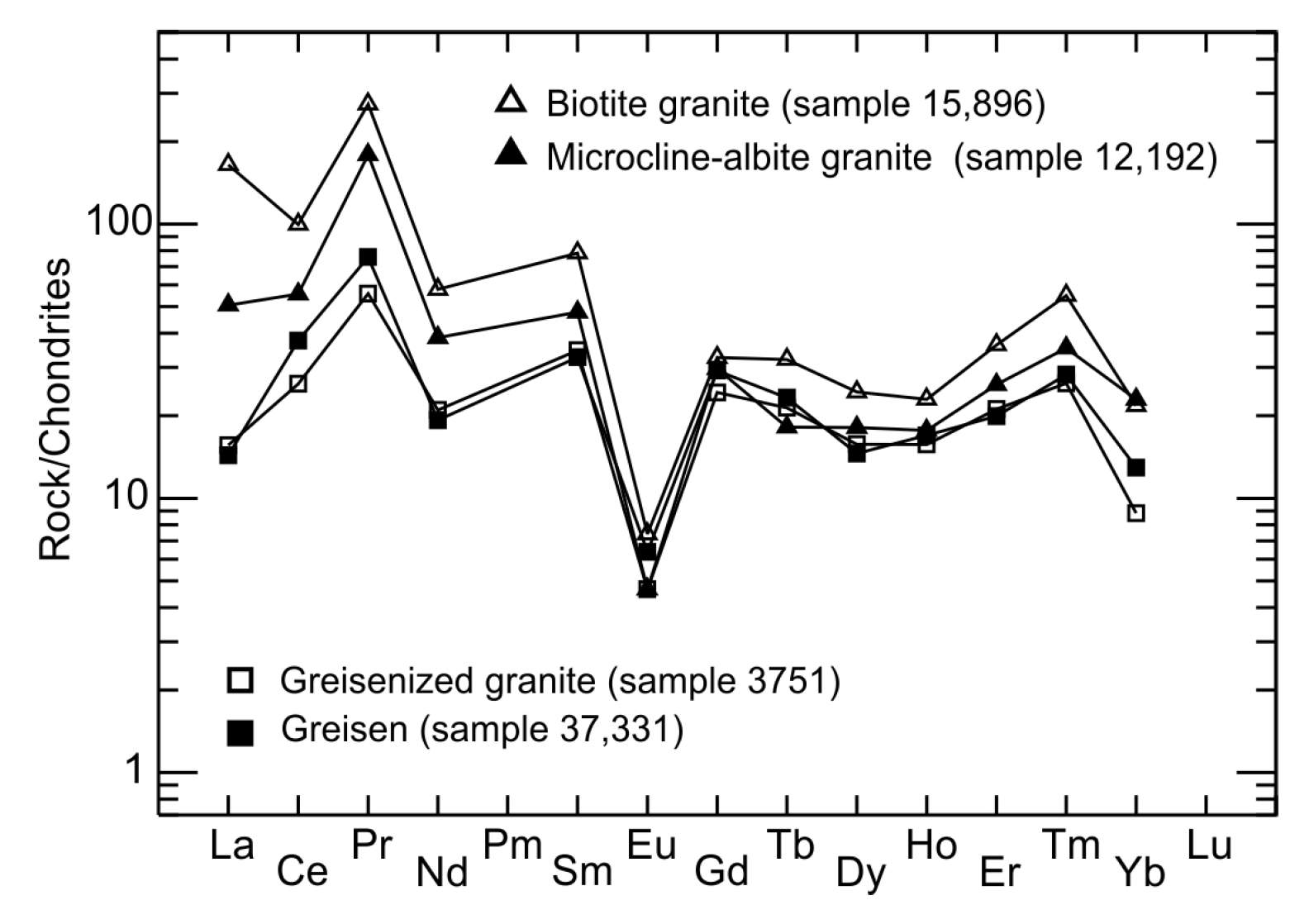
4.5. Mineralization of the Polyarnoe Deposit
5. Burgali Ore Field (Verkhne–Burgali Deposit)
5.1. Geological Setting
5.2. Age of the Studied Rocks
5.3. Petrography and Mineralogy of Granitoids
5.4. Geochemistry of Granitoids
5.5. Ore Mineralization of the Verkhne–Burgali Deposit
6. The Arga Ynnakh Khaya Ore Field (Kester Deposit)
6.1. Geological Setting
6.2. Age of Granitoids
6.3. Petrography and Mineralogy of Granitoids
6.4. Geochemistry of Granitoids
6.5. Ore Mineralization of the Kester Deposit
7. Discussion
7.1. Early Granitoids of the Studied ore Fields
7.2. Li-F Microcline–Albite Granites
7.3. Source of Volatiles for Studied Microcline–Albite Granites
7.4. Ore Mineralization of the Studied Microcline–Albite Granites
7.5. Tectonic Setting of the Studied Granitoids
8. Conclusions
- (1)
- In the north of the Verkhoyansk–Kolyma orogenic belt, two types of Li-F granites are found: low P and high P. They differ in their chemical composition and have different forms of genesis. According to their geochemical composition, they correspond to A1-type granites. These granites were formed during the Aptian period, probably at a post-collisional extension in the early stages of the formation of the Aptian–Late Cretaceous Indigirka belt of crust extension.
- (2)
- Low-P Li-F microcline–albite granites (Omchikandya massif, Polyarnoe deposit) are late derivatives of the melt that formed earlier S-type biotite granites. It is assumed that their parent melt originated at deep levels in the same magma chamber from which the biotite granites were produced.
- (3)
- High-P Li-F granites (Verkhne–Burgali ethmolith and Kester harpolith) crystallized from melts originated at a lower crustal level under the influence of a deep fluid flow related to ascending diapirs of alkaline-ultrabasic or alkaline-basic compositions, which were likely the main sources of Li, F, and P.
- (4)
- Low-P and high-P Li-F granites, which are enriched in rare metals, produce Li deposits in association with Sn, W, Ta, and Nb mineralization. The rare metal index for low-P granites corresponds to rocks of high ore potential, and that for high-P granites, to rocks of ultra-high ore potential [42]. In the low-P Li-F granites, mineralization is localized in the greisenized granites and greisens in the apical parts of the granite massifs. In the high-P Li-F granites, mineralization is distributed throughout the massifs.
Supplementary Materials
Author Contributions
Funding
Data Availability Statement
Acknowledgments
Conflicts of Interest
References
- Kesler, S.E.; Gruber, P.W.; Medina, P.A.; Keoleian, G.A.; Everson, M.P.; Wallington, T.J. Global lithium resources: Relative importance of pegmatite, brine and other deposits. Ore Geol. Rev. 2012, 48, 55–69. [Google Scholar] [CrossRef]
- Evans, K.R. Chapter 10—Lithium. In Critical Metals Handbook; Gunn, G., Ed.; Wiley-Blackwell: Hoboken, NJ, USA, 2014; pp. 230–260. [Google Scholar] [CrossRef]
- Tkachev, A.V.; Rundqvist, D.V.; Vishnevskaya, N.A. Metallogeny of lithium through geological time. Russ. J. Earth Sci. 2018, 18, ES6002. [Google Scholar] [CrossRef]
- Teten’kin, D.D.; Petrov, E.I. (Eds.) State Report “On the State and Use of Mineral Resources of the Russian Federation in 2021”; Ministry of Natural Resources and Ecology of the Russian Federation, Federal Agency on Natural Resources Management: (Rosnedra): Moscow, Russia, 2022; p. 622. Available online: https://vims-geo.ru/ru/reports/gd/ (accessed on 1 January 2021). (In Russian)
- Trunilina, V.A.; Orlov, Y.S.; Zaitsev, A.I.; Roev, S.P. High Phosphorous Lithium—Fluorine Granites of Eastern Yakutia (Verkhoyansk-Kolyma Orogenic Region). Russ. J. Pac. Geol. 2019, 13, 82–98. [Google Scholar] [CrossRef]
- Alekseev, V.I. Type intrusive series of the Far East belt of lithium-fluoric granites and its ore content. J. Min. Inst. 2022, 255, 377–392. [Google Scholar] [CrossRef]
- Breiter, K.; Seltmann, R.; Thomas, R. The phosphorus-rich rare metal granite system of Podlesi, Czech Republic. In Proceedings of the Fourth Biennial SGA Meeting, Turku, Finland, 11–13 August 1997; Papunen, H., Ed.; A.A. Balkema: Rotterdam, The Netherlands, 1997; pp. 833–835. Available online: https://www.researchgate.net/publication/236953148 (accessed on 11 August 1997).
- Pollard, P.J. The Yichun Ta-Sn-Li Deposit, South China: Evidence for Extreme Chemical Fractionation in F-Li-P-Rich Magma. Econ. Geol. 2021, 116, 453–469. [Google Scholar] [CrossRef]
- Kovalenko, V.I.; Kostitsyn, Y.A.; Yarmolyuk, V.V.; Budnikov, S.V.; Kovacs, V.P.; Kotov, A.B.; Salnikova, E.B.; Antipin, V.S. Magma sources and isotopic (SR, ND) evolution of rare-metal LI-F granites. Petrology 1999, 7, 383–409. [Google Scholar]
- Liu, W.; Liu, C.Q.; Masuda, A. Complex trace-element effects of mixing-gractional crystallization composite processes: Applications to the Alraer granite pluton, Altay Mountains, Xingjiang, Northwestern China. Chem. Geol. 1997, 135, 103–124. [Google Scholar] [CrossRef]
- Marakushev, A.A.; Khazov, R.A.; Shapovalov, Y.B.; Pavlov, G.I.; Bezmen, N.I. The nature of the stratification of lithium-fluorine granites. Reports. USSR Acad. Sci. 1991, 318, 695–699. (In Russian) [Google Scholar]
- Nedosekin, Y.D. Rare-Metal Granites of the North-East of the USSR; Nauka: Moscow, Russia, 1988; p. 141. (In Russian) [Google Scholar]
- Raimbault, L.; Cuney, M.; Azencott, C.; Duthou, J.L.; Joron, J.L. Geochemical evidence for multistage magmatic genesis of Ta-Sn-Li mineralization in the granite at Beauvoir, French Massif Central. Econ. Geol. 1995, 90, 548–576. [Google Scholar] [CrossRef]
- Green, T.H. Significance of Nb/Ta as an indicator of geochemical processes in the crust-mantle system. Chem. Geol. 1995, 120, 347–359. [Google Scholar] [CrossRef]
- Kozlov, V.D. Trace-element composition and origin of granitoids from the Shakhtama complex and Kukul’bei rare-metal complex (Aga zone, Transbaikalia). Geol. Geophys. 2011, 52, 676–689. (In Russian) [Google Scholar] [CrossRef]
- Liu, T.; Wang, H.; Tian, S.; Wang, D.; Li, X.; Fu, X. Genesis of the Jiajika superlarge lithium deposit, Sichuan, China: Constraints from He–Ar–H–O isotopes. Acta Geochim. 2023, 42, 517–534. [Google Scholar] [CrossRef]
- Trunilina, V.A.; Roev, S.P.; Orlov, Y.A. Granitoids of the Batholitic Belts in the Northeastern Verkhoyansk-Kolyma Mesozoides; Media-Holding “Yakutia”: Yakutsk, Russia, 2013; p. 187. (In Russian) [Google Scholar]
- Janoušek, V.; Farrow, C.M.; Erban, V. Interpretation of whole-rock geochemical data in igneous geochemistry: Introducing Geochemical Data Toolkit (GCDkit). Petrology 2006, 47, 1255–1259. [Google Scholar] [CrossRef]
- Korinevsky, E.V. Petroexplorer–a system for creating geochemical information and analytical arrays in the process of case studies. Geoinformatika 2015, 4, 48–53. (In Russian) [Google Scholar]
- Jung, S.; Pfander, J.A. Source composition and melting temperatures of orogenic granitoids–constrains from CaO/Na2O, Al2O3/TiO2 and accessory mineral saturation thermometry. Eur. J. Mineral. 2007, 1, 5–40. [Google Scholar] [CrossRef]
- Belyaev, G.M.; Rudnik, V.A. Formational-Genetic Types of Granitoids; Nedra: Leningrad, Russia, 1978; p. 168. (In Russian) [Google Scholar]
- Parfenov, L.M.; Kuz’min, M.I. (Eds.) Tectonics, Geodynamics and Metallogeny of the Sakha Republic (Yakutia); MAIK Nauka/Inteperiodica: Moscow, Russia, 2001; p. 571. (In Russian) [Google Scholar]
- Nokleberg, W.J. (Ed.) Metallogenesis and Tectonics of Northeast Asia; U.S. Geological Survey Professional Paper 1765: Washington, DC, USA, 2010; p. 624.
- Layer, P.W.; Newberry, R.; Fujita, K.; Parfenov, L.M.; Trunilina, V.A.; Bakharev, A.G. Tectonic setting of the plutonic belts of Yakutia, Northeast Russia, based on 40Ar/39Ar and trace element geochemistry. Geology 2001, 29, 167–170. [Google Scholar] [CrossRef]
- Akinin, V.V.; Miller, E.L.; Toro, J.; Prokopiev, A.V.; Gottlieb, E.S.; Pearcey, S.; Polzunenkov, G.O.; Trunilina, V.A. Episodicity and the dance of late Mesozoic magmatism and deformation along the northern circum-Pacific margin: North-eastern Russia to the Cordillera. Earth-Sci. Rev. 2020, 208, 103272. [Google Scholar] [CrossRef]
- Danilov, V.G.; Afanas’eva, E.V.; Ivanenko, G.V.; Simonova, L.S.; Shulgina, V.S. State Geological Map of the Russian Federation, scale 1:200,000, 2nd ed.; Yano-Indigirskaya Series. Sheet R-54-XXIII-XXIV (Berelekhskaya Area). Explanatory Note; VSEGEI; Cartographic Factory: St. Petersburg, Russia, 2018; p. 362. (In Russian) [Google Scholar]
- Whitney, D.L. Abbreviations for Names of Rock-Forming Minerals. Am. Mineral. 2010, 95, 185–187. [Google Scholar] [CrossRef]
- Gusev, A.I. Typification of granitoids, based on biotite composition. Successes Mod. Nat. Sci. 2009, 4, 54–57. (In Russian) [Google Scholar]
- Bushlyakov, I.N.; Kholodnov, V.V. Halogens in Petrogenesis of Granitoids; Nedra: Moscow, Russia, 1986; p. 192. (In Russian) [Google Scholar]
- Tindle, A.G.; Webb, R.P. Estimation of lithium contents in trioctahedral micas using microprobe data: Application to micas from granitic rocks. Eur. J. Mineral. 1990, 2, 595–610. [Google Scholar] [CrossRef]
- Brown, G.G. A comment on the role of water in the partial fusion of crystal rocks. Earth Planet. Sci. Lett. 1970, 9, 13–22. [Google Scholar] [CrossRef]
- Sharpenok, L.N.; Kostin, A.E.; Kukharenko, E.A. TAS-diagram sum of alkalis-silica for chemical classification and diagnostics of plutonic rocks. Reg. Geol. Metallog. 2013, 56, 40–50. (In Russian) [Google Scholar]
- Strekeisen, A.; Le Maitre, P.W. A chemical approximation to the modal QAPF classification of igneous rocks. Neues Yahrbuch Mineral. 1979, 136, 169–206. [Google Scholar]
- Whalen, G.B.; Kenneth, L.; Currie, K.L.; Chappel, B.W. A-type granites: Geochemical characteristics, discrimination and petrogenesis. Contrib. Mineral. Petrol. 1987, 95, 407–419. [Google Scholar] [CrossRef]
- Ovchinnikov, L.N. Applied Geochemistry; Nedra: Moscow, Russia, 1990; p. 248. (In Russian) [Google Scholar]
- Maniar, P.D.; Piccoli, P.M. Tectonic discrimination of granitoids. Geol. Soc. Am. Bull. 1989, 101, 635–643. [Google Scholar] [CrossRef]
- Frost, C.D.; Frost, B.R. On Ferroan (A-type) granitoids: Their compositional variability and modes of origin. J. Pet. 2011, 52, 39–53. [Google Scholar] [CrossRef]
- Maeda, J. Opening of the Kuril Basin deduced from the magmatic history of Central Hokkaido, northern Japan. Tectonophysics 1990, 174, 235–255. [Google Scholar] [CrossRef]
- Datsenko, V.M. Petrogeochemical typification of granitoids of the south-western framing of the Siberian platform. In Materials the Second All-Russian Petrographic Meeting; Yushkin, N.P., Ed.; Komi Scientific Center: Syktyvkar, Russia, 2000; pp. 270–274. (In Russian) [Google Scholar]
- Gerdes, A.; Worner, G.; Henk, A. Post-collisional granite generation and HT-LP metamorphism by radiogenic heating: The Variscan South Bohemian Batholith. Geol. Soc. 2000, 157, 577–587. [Google Scholar] [CrossRef]
- Jackson, J.A. (Ed.) Glossary of Geology, 4th ed.; American Geological Institute: Alexandria, Virginia, 1997. [Google Scholar]
- Tauson, L.V. Geochemical Types and Ore Potential of Granotoids; Nauka: Moscow, Russia, 1977; p. 279. (In Russian) [Google Scholar]
- Taylor, S.R.; McLennan, S.M. The Continental Crust: Its Composition and Evolution; Blackwell: Oxford, UK, 1985; p. 349. [Google Scholar]
- Irber, W. The lanthanide tetrad effect and its correlation with K/Rb, Eu/Eu*, Sr/Eu, Y/Ho, and Zr/Hf of evolving peraluminious granite suites. Geochem. Cosmochem. Acta 1999, 63, 489–508. [Google Scholar] [CrossRef]
- Sun, S.-S.; McDonough, W.F. Chemical and isotopic systematics of oceanic basalts: Implications for mantle composition and processes. Geol. Soc. Lond. Spec. Publ. 1989, 42, 313–345. [Google Scholar] [CrossRef]
- Vdovina, L.G.; Baeva, I.G. Complex tantalum-containing objects of the territory of activity of OAO Yangeologiya. Bull. State Comm. Geol. Repub. Sakha 2011, 1, 87–92. (In Russian) [Google Scholar]
- Bykhovskiy, L.Z.; Novikov, V.P.; Sveshnikova, V.I. Typomorphic features of cassiterites and wolframites and their significance in prospecting and evaluation of ore deposits. In Typomorphism of Minerals and Its Practical Significance; Nedra: Moscow, Russia, 1972; pp. 162–168. (In Russian) [Google Scholar]
- Nenashev, N.I. Magmatism and Evolution of Ore-Magmatic Clusters in the East Yakutia; Nauka: Novosibirsk, Russia, 1979; p. 142. (In Russian) [Google Scholar]
- Rudolfi, R.; Renzolli, A. Calcic amphiboles in calc-alkaline and alkaline magmas: Thermobarometric and chemometric empirical equations valid up to 1130 °C and 2.2 Gpa. Contrib. Mineral. Petrol. 2012, 163, 877–895. [Google Scholar] [CrossRef]
- Yavuz, F. Win Pyrox: A Windows program for pyroxene calculation classification and thermobarometry. Am. Mineral. 2013, 98, 1338–1359. [Google Scholar] [CrossRef]
- Pupin, J.P. Zircon and Granite Petrology. Contrib. Mineral. Petrol. 1980, 73, 207–220. [Google Scholar] [CrossRef]
- Piskunov, B.M.; Abdurakhmanova, A.I.; Kim, C.U. Composition-depth ratio for volcanoes of the Kuril island arc and its petrological significance. Volcanol. Seismol. 1979, 4, 57–67. (In Russian) [Google Scholar]
- Nekrasov, I.Y. Geochemistry of Tin and Rare Elements of the Verkhoyansk-Chukotka Fold Area; Nauka: Moscow, Russia, 1966; p. 379. (In Russian) [Google Scholar]
- Prokopiev, A.V.; Pavlova, G.G.; Borisenko, A.S.; Travin, A.V.; Toro, J.; Tretyakov, F.F.; Zaitsev, A.I.; Bakharev, A.G.; Trunilina, V.A.; Vasiliev, D.A.; et al. Dykes and plutons of transverse magmatic belts of the Verkhoyansk fold-and-thrust belt: New geochronological data and their geodynamic interpretation. In Tectonics and Geodynamics of the Phanerozoic Folded Belts and Platforms; GEOS: Moscow, Russia, 2010; Volume II, pp. 174–177. (In Russian) [Google Scholar]
- Prokopiev, A.V.; Borisenko, A.S.; Gamyanin, G.N.; Pavlova, G.G.; Fridovsky, V.Y.; Kondrat’eva, L.A.; Anisimova, G.S.; Trunilina, V.A.; Ivanov, A.I.; Travin, A.V.; et al. Age constraints and tectonic settings of metallogenic and magmatic events in the Verkhoyansk-Kolyma folded area. Russ. Geol. Geophys. 2018, 59, 1237–1253. [Google Scholar] [CrossRef]
- Trunilina, V.A.; Orlov, Y.S.; Roev, S.P.; Zaitsev, A.I. Composition and genetic aspects of the formation of A-type granites of the Verkhoyansk-Kolyma folded region. Otechestvennaya Geol. 2008, 5, 99–109. (In Russian) [Google Scholar]
- Orlov, Y.S.; Filimonov, Y.A.; Boyarshinov, V.V. On the issue of the genesis of alaskites of the Arga-Ynnakh-Khaya massif (Eastern Yakutia). In Geology and Minerals of the Verkhoyansk-Kolyma Folded System; Yakutian Publishing House: Yakutsk, Russia, 1984; pp. 74–81. (In Russian) [Google Scholar]
- Kokunin, M.V. Rare minerals of a forgotten deposit. Otechestvennaya Geol. 2011, 1, 72–82. (In Russian) [Google Scholar]
- Vdovina, L.G.; Skuba, V.D. State Geological Map of the Russian Federation, Scale 1:200,000, 2nd ed.; Verkhoyanskaya Series; Sheet Q-53-III, IV (Batagai). Explanatory Note; VSEGEI: St. Petersburg, Russia, 2002; p. 233. (In Russian) [Google Scholar]
- Eby, G.N. Chemical subsivision of the A-type granitoids petrogenetic and tectonic implication. Geology 1992, 20, 641–644. [Google Scholar] [CrossRef]
- Bonin, B. A-type granites and related rocks: Evolution of a concept, problems and prospects. Lithos 2007, 97, 1–29. [Google Scholar] [CrossRef]
- Smith, D.R.; Noblett, J.; Wobus, R.A.; Unruh, D.; Douglass, J.; Beane, R.; Davis, C.; Goldman, S.; Kay, G.; Gustavson, B.; et al. Petrology and geochemistry of late-stage intrusions of the A-type, Mid-Proterozoic pikes peak batholith (Central Colorado, USA): Implications for petrogenetic models. Precambrian Res. 1999, 98, 271–305. [Google Scholar] [CrossRef]
- Anderson, I.C.; Frost, C.D.; Frost, B.R. Petrogenesis of the Red Mountain pluton, Laramie anorthosite complex, Wyoming: Implications for the origin of A-type granite. Precambrian Res. 2003, 124, 243–256. [Google Scholar] [CrossRef]
- Litvinovsky, B.A.; Jahn, B.M.; Eyal, M. Mantle-Derived Sources of Syenites from the A-type Igneous Suites—New Approach to the Provenance of Alcaline Silicic Magmas. Lithos 2015, 232, 242–265. [Google Scholar] [CrossRef]
- Taylor, R.P. Petrological and geochemical characteristics of the Pleasant Ridge zinwaldite-topaz granite, southern New Brunswick and comparisons with other topaz-bearing felsic rocks. Can. Mineral. 1992, 30, 895–921. [Google Scholar]
- Takahashi, Y.; Yoshida, H.; Sato, N.; Hama, K.; Yusa, Y.; Shimizu, H. W- and M-type tetrad effect in REE patterns for water-rock systems in the Tono uranium deposit, central Japan. Chem. Geol. 2002, 184, 311–335. [Google Scholar] [CrossRef]
- Tauson, L.V.; Gundobin, G.M.; Zorina, L.D. Geochemical Fields of Ore-Magmatic Systems; Nauka: Novosibirsk, Russia, 1987; p. 202. (In Russian) [Google Scholar]
- Ryabov, V.V.; Zolotukhin, V.V. Minerals of Differentiated Traps; Nauka: Novosibirsk, Russia, 1977; p. 387. (In Russian) [Google Scholar]
- Fed’kin, A.; Seltmann, R.; Zaraisky, G.; Bezmen, N. Experimental study of the effect of fluorine and phosphorus on layering in Li-F granites. Eighth International Symposium. Econ. Geol. 1995, 90, 548–576. [Google Scholar]
- Manning, D.A.C. Influence of fluorine on liquidus phase relations in the Qz-Ab-Or system with excess water at 1 kb. Contrib. Mineral. Petrol. 1981, 76, 206–215. [Google Scholar] [CrossRef]
- Masuda, A.; Kawakami, O.; Dohmoto, Y.; Takenaka, T. Lanthanide tetrad effects in nature: Two mutually opposite types, W and M. Geochem. J. 1987, 21, 119–124. [Google Scholar] [CrossRef]
- Zhao, Z.; Bao, Z.; Qiao, Y. A peculiar composite M- and W-type REE tetrad effect: Evidence from the Shuiquangou alkaline syenite complex, Hebei Province, China. Chin. Sci. Bull. 2010, 55, 2684–2696. [Google Scholar] [CrossRef]
- Christiansen, E.H.; Bikun, J.V.; Sheridan, M.F.; Burt, D.M. Geochemical evolution of topaz rhyolites from the Thomas Range and Spor Mountain, Utah. Am. Mineral. 1984, 69, 223–236. [Google Scholar]
- Bea, F.; Pereira, M.D.; Corretge, L.G.; Fershtater, G.B. Differentiation of strongly peralumi-nous, perphosphorus granites: The Pedrobernardo pluton, Central Spain. Geochim. Cosmochim. Acta 1994, 58, 2609–2627. [Google Scholar] [CrossRef]
- Trunilina, V.A.; Orlov, Y.S.; Fedotov, M.V. Composition of the crystalline basement of the Verkchoyansk-Kolyma Mesozoides. In Zeitschrift für Geologische Wissenschaften; Akademie-Verlag: Berlin, Germany, 1994; pp. 147–152. [Google Scholar]
- Trunilina, V.A.; Prokopiev, A.V. Petrology of Granites of the Tommot Rare-Earth Ore Field (Verkhoyansk-Kolyma Orogenic Belt). Minerals 2022, 12, 1347. [Google Scholar] [CrossRef]
- Trunilina, V.A.; Roev, S.P. Petrology of dykes of the Dzhakhtardakh volcanogenic field and their relationship with mineralization. Otechestvennaya Geol. 2016, 6, 35–42. (In Russian) [Google Scholar]
- Trunilina, V.A.; Roev, S.P.; Orlov, Y.S. Mineralogy, petro-, and geochemistry of the composite dikes of the Takalkan ore-magmatic cluster (Polousny synclinorium of the Verkhoyansk–Kolyma orogenic area). Russ. J. Pac. Geol. 2015, 9, 359–372. Available online: http://link.springer.com/article/10.1134/S1819714015050061 (accessed on 10 October 2015). [CrossRef]
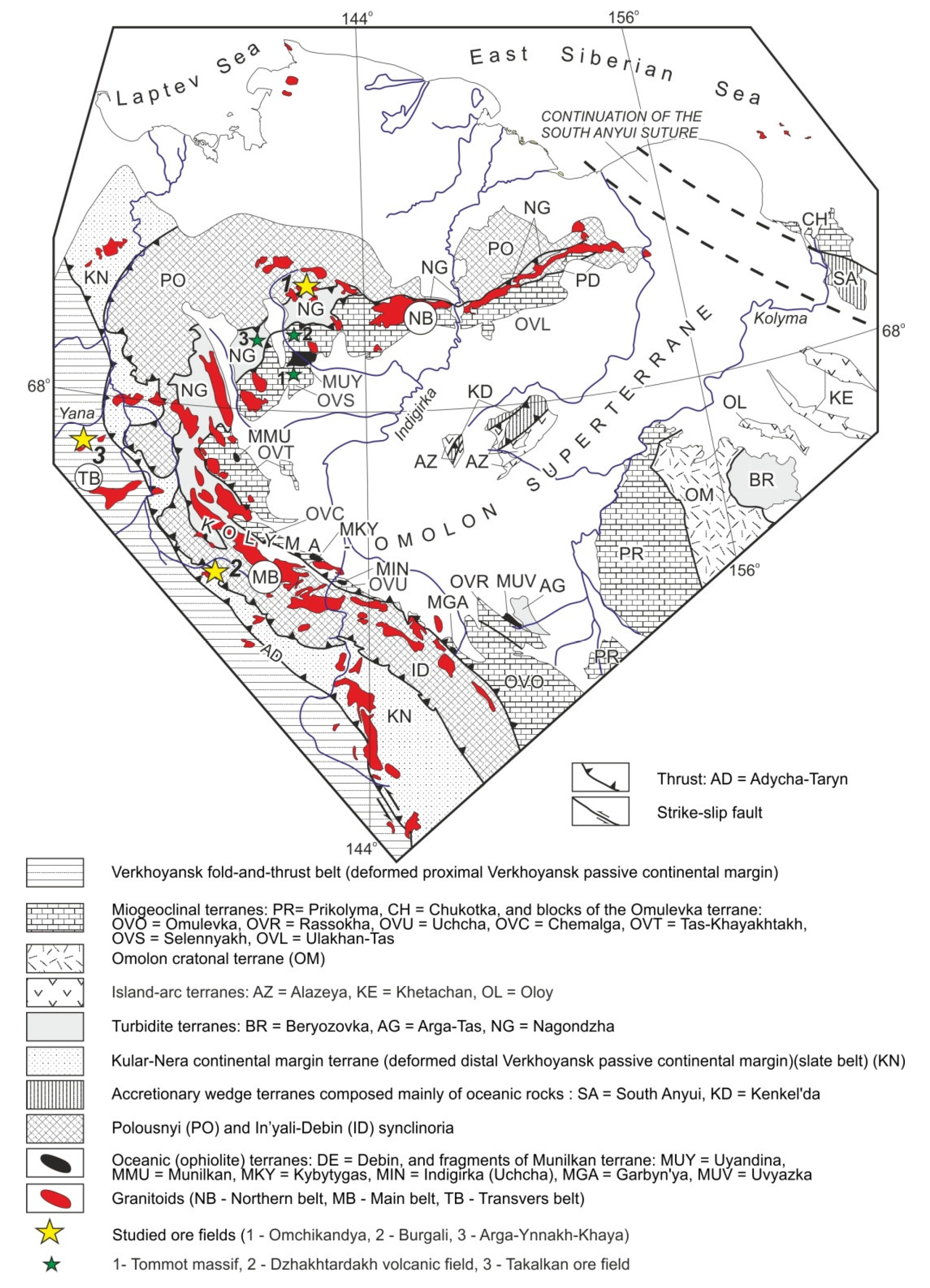
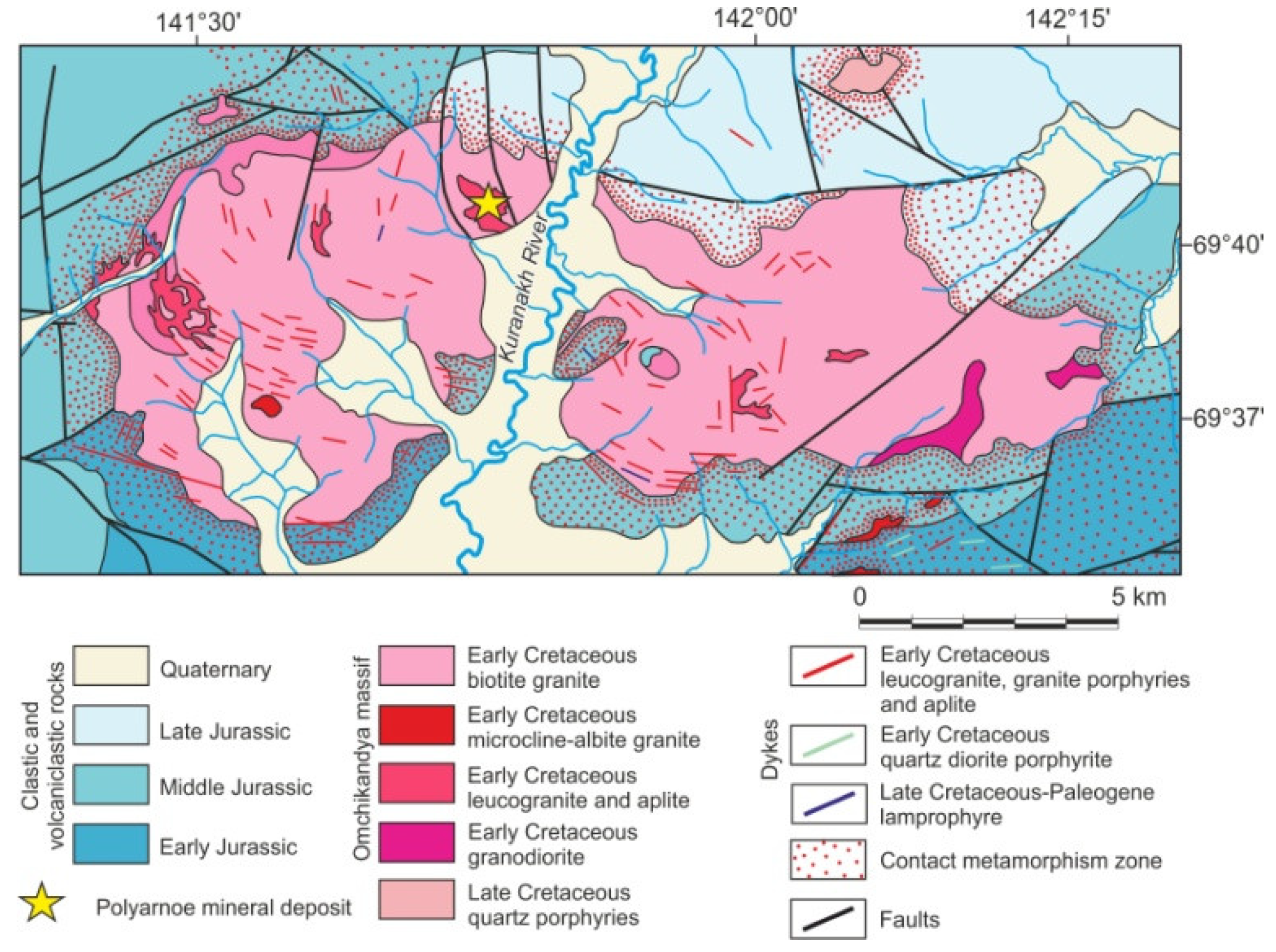
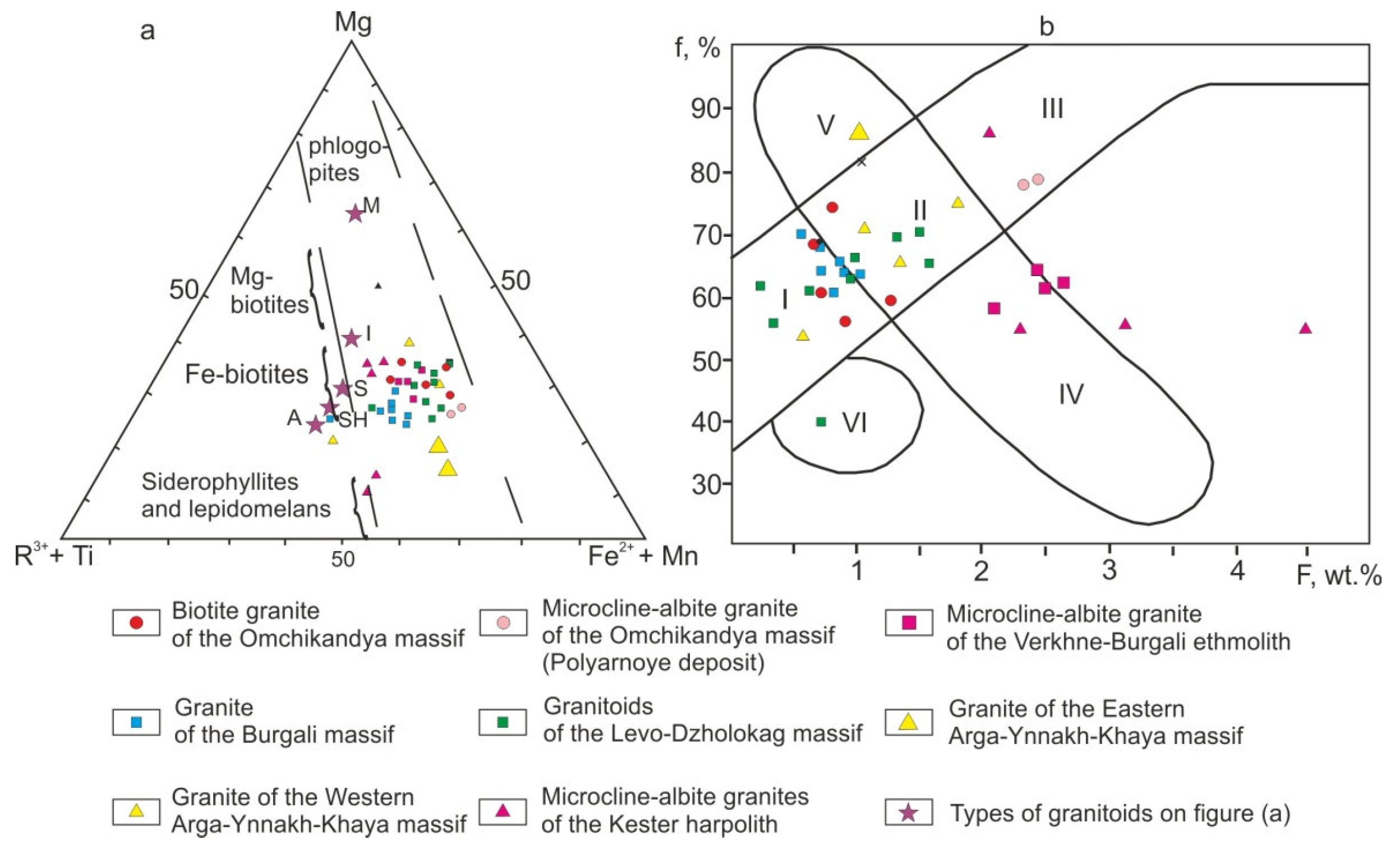
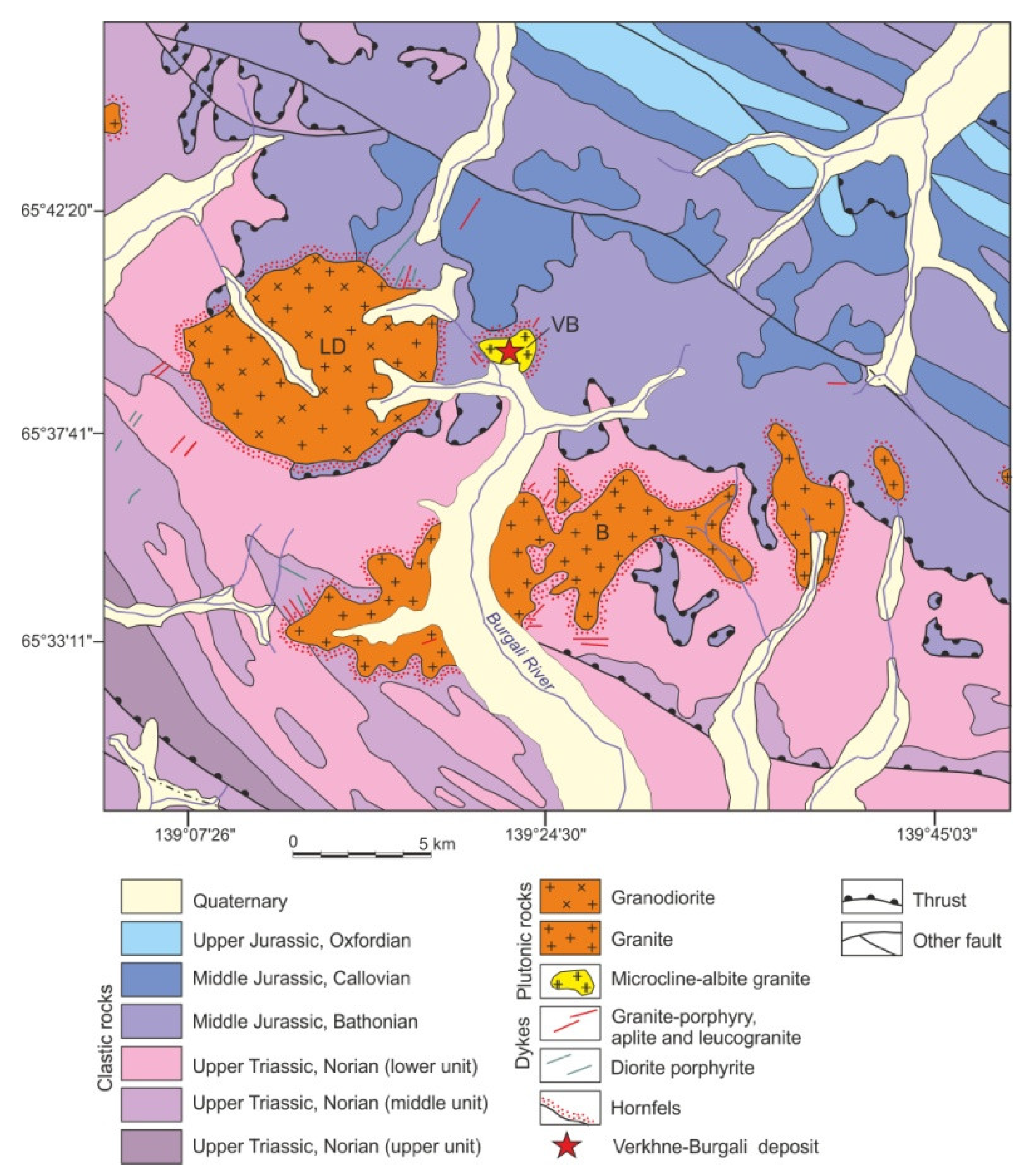
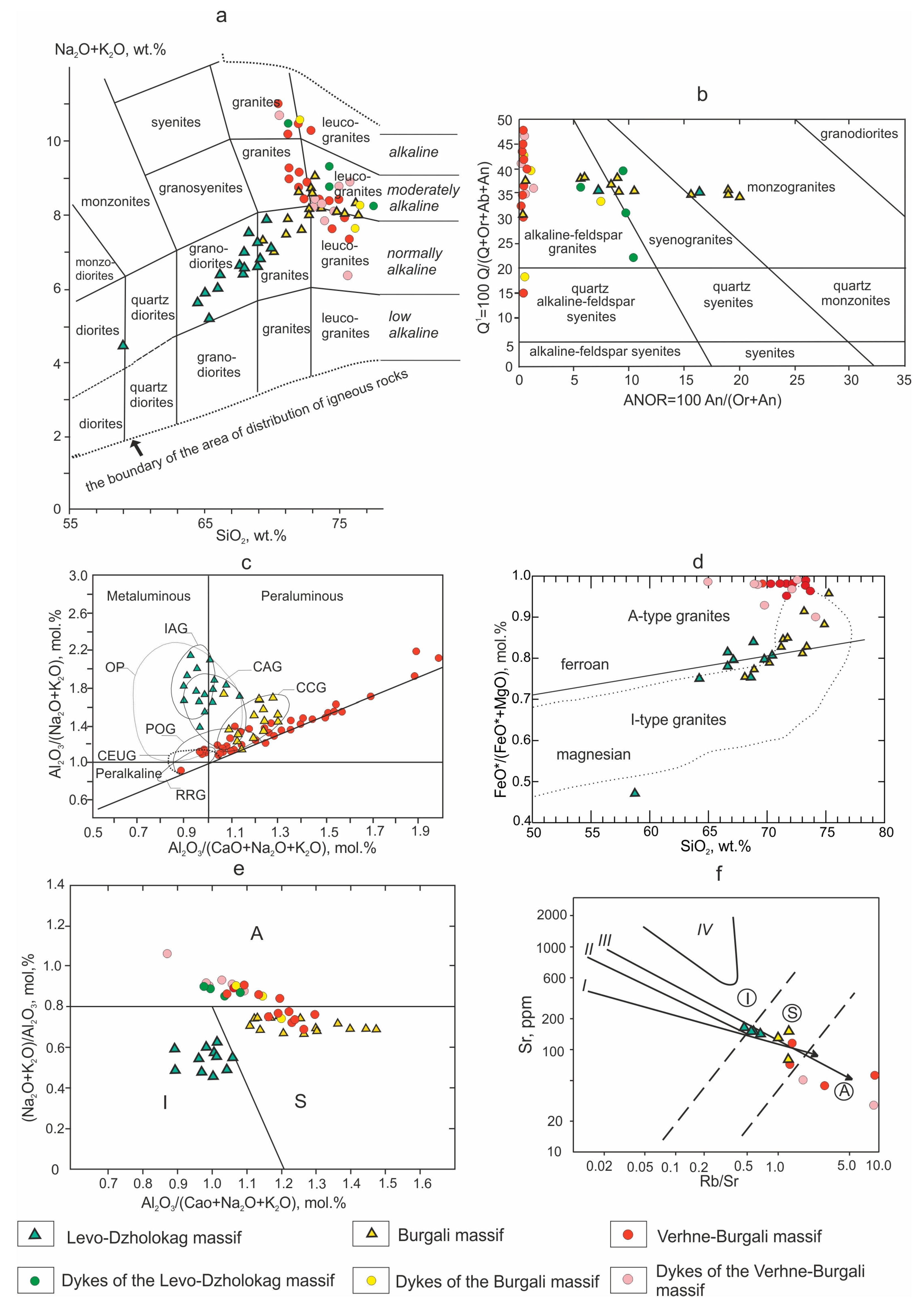
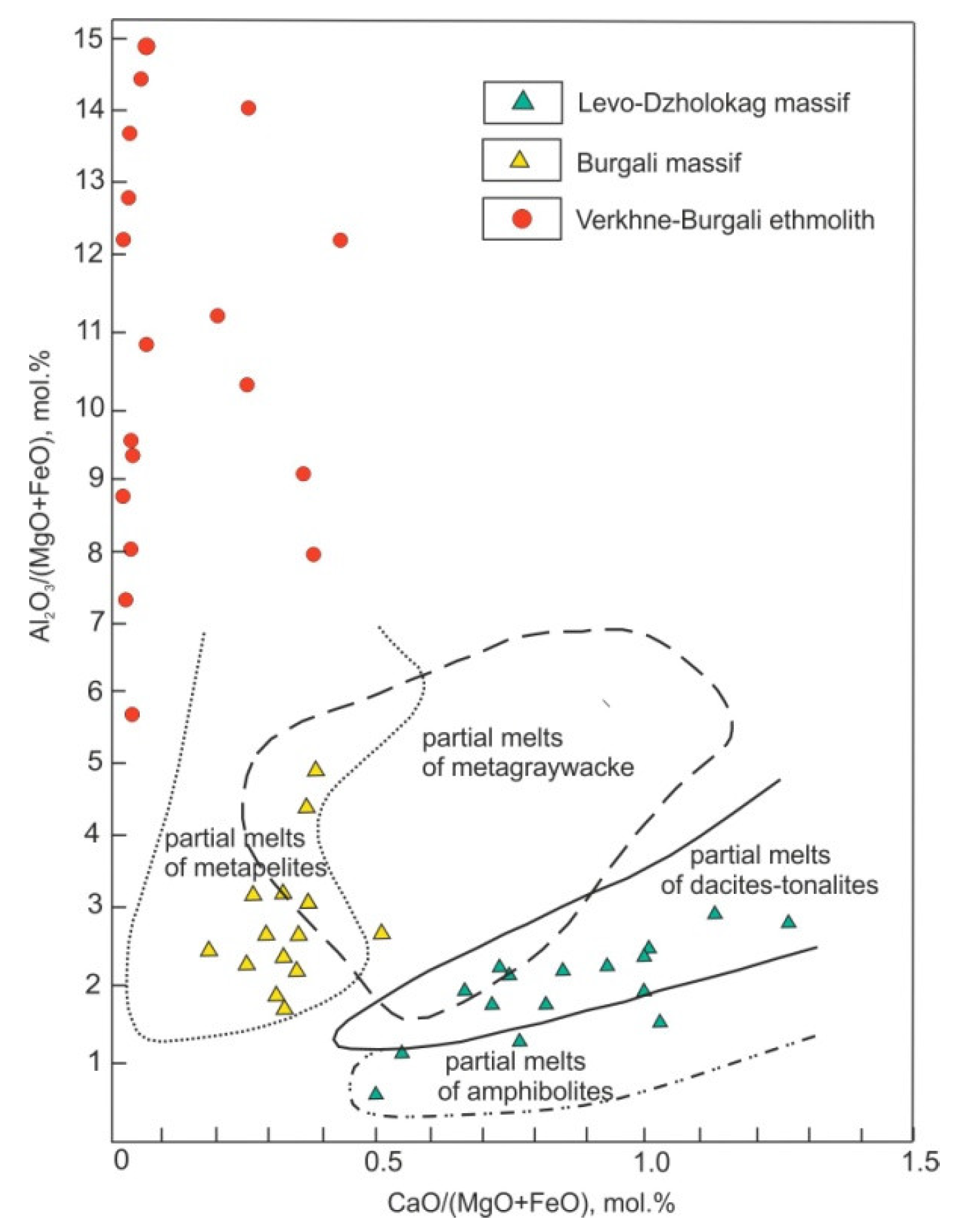
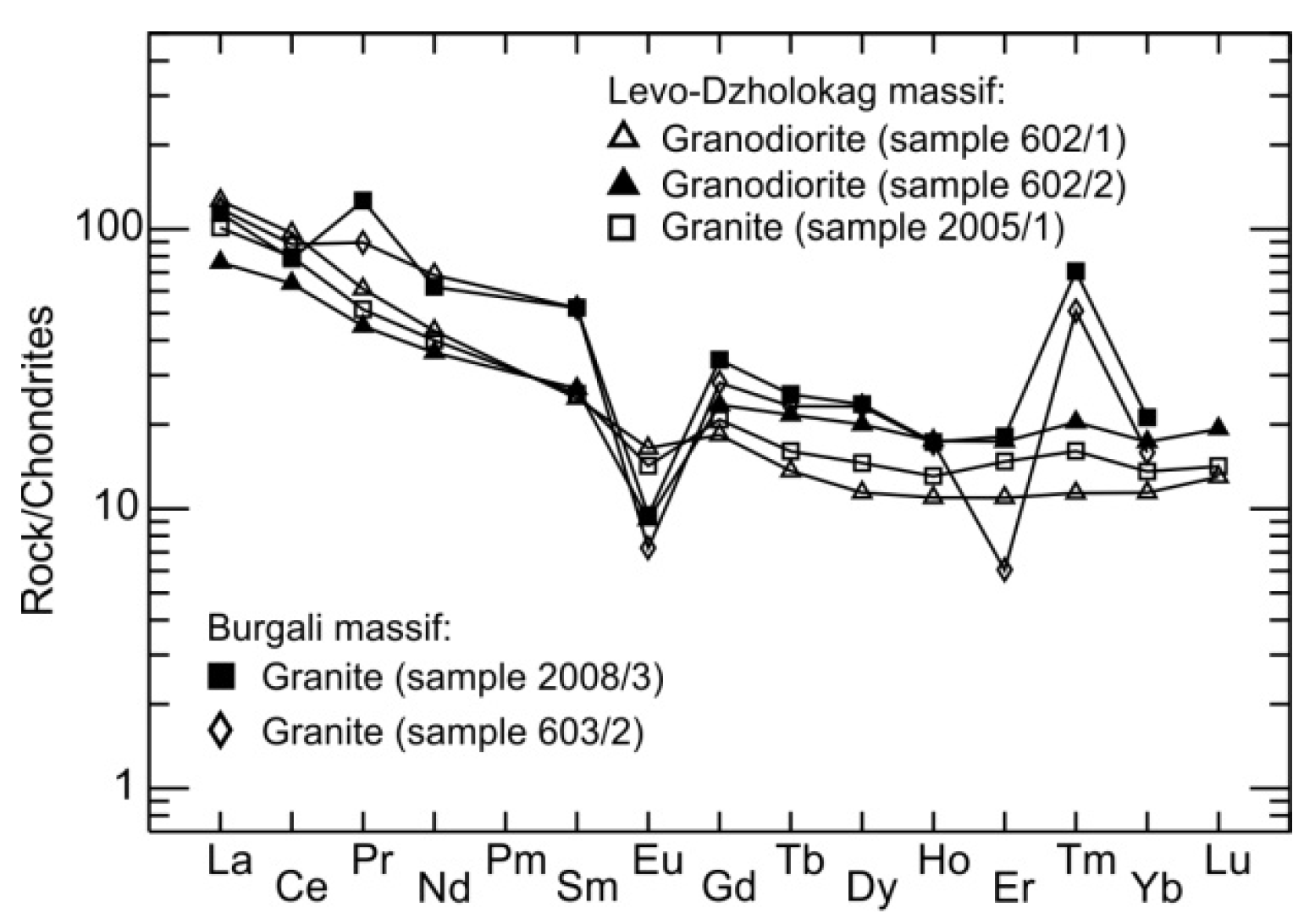
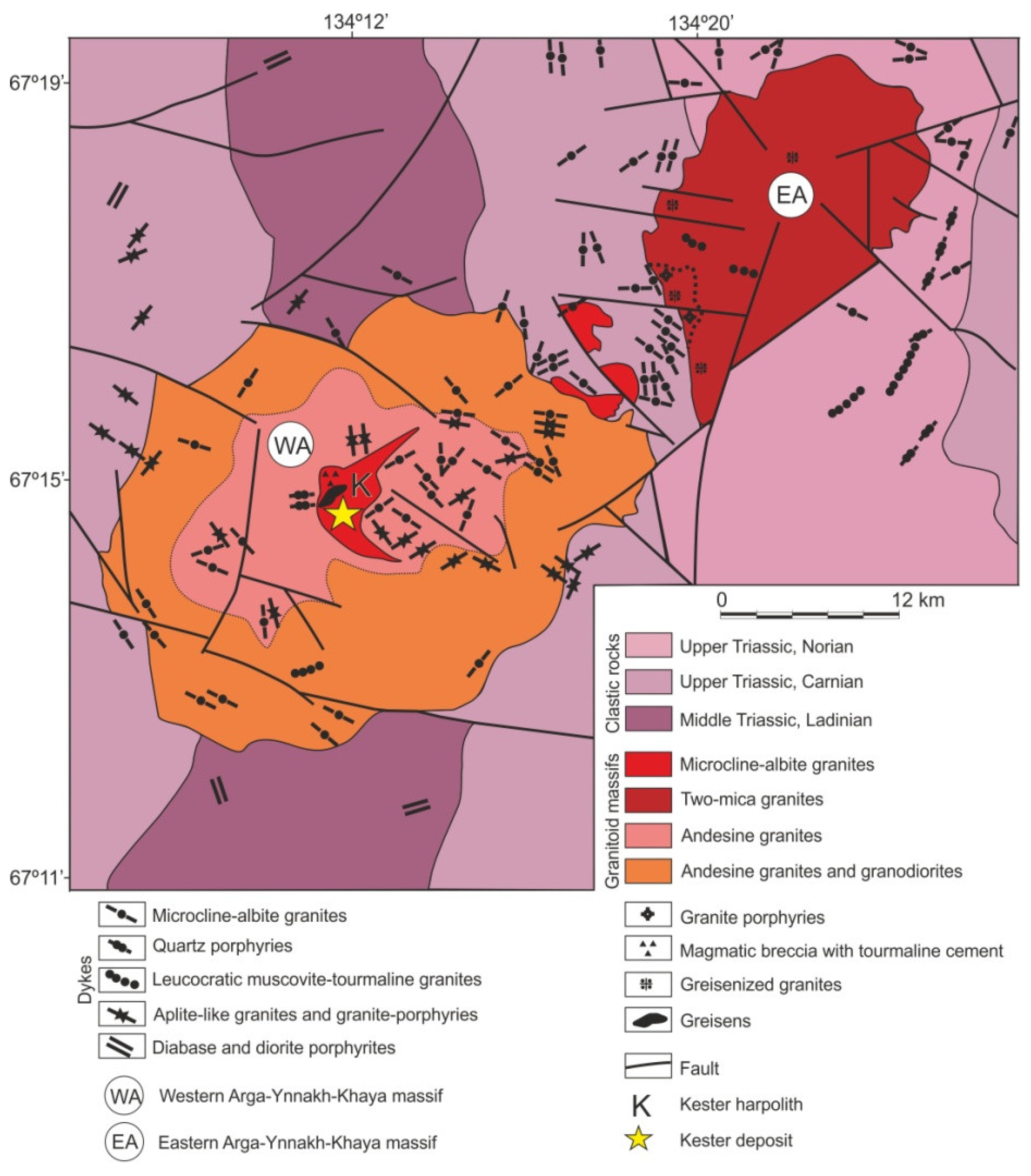
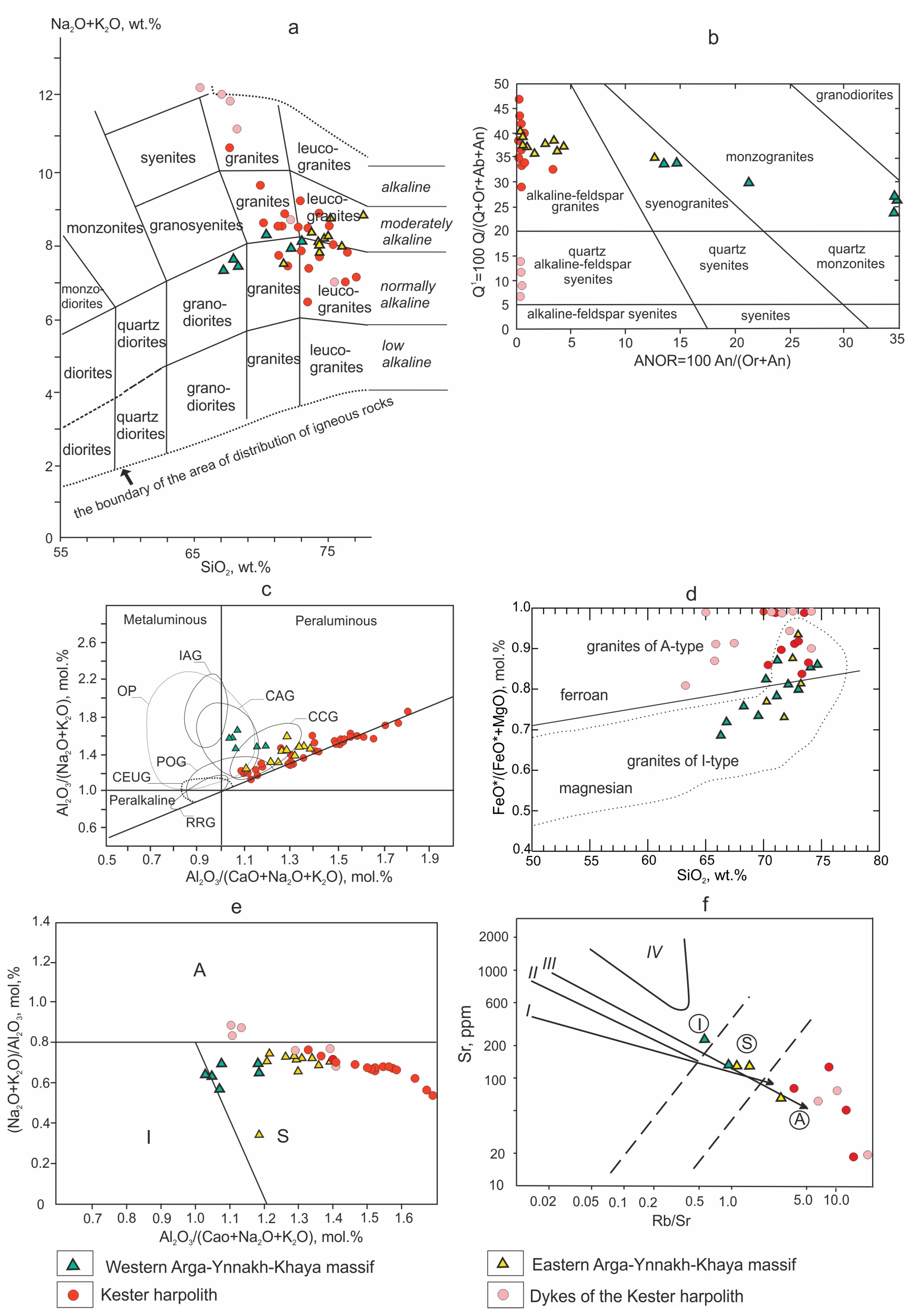

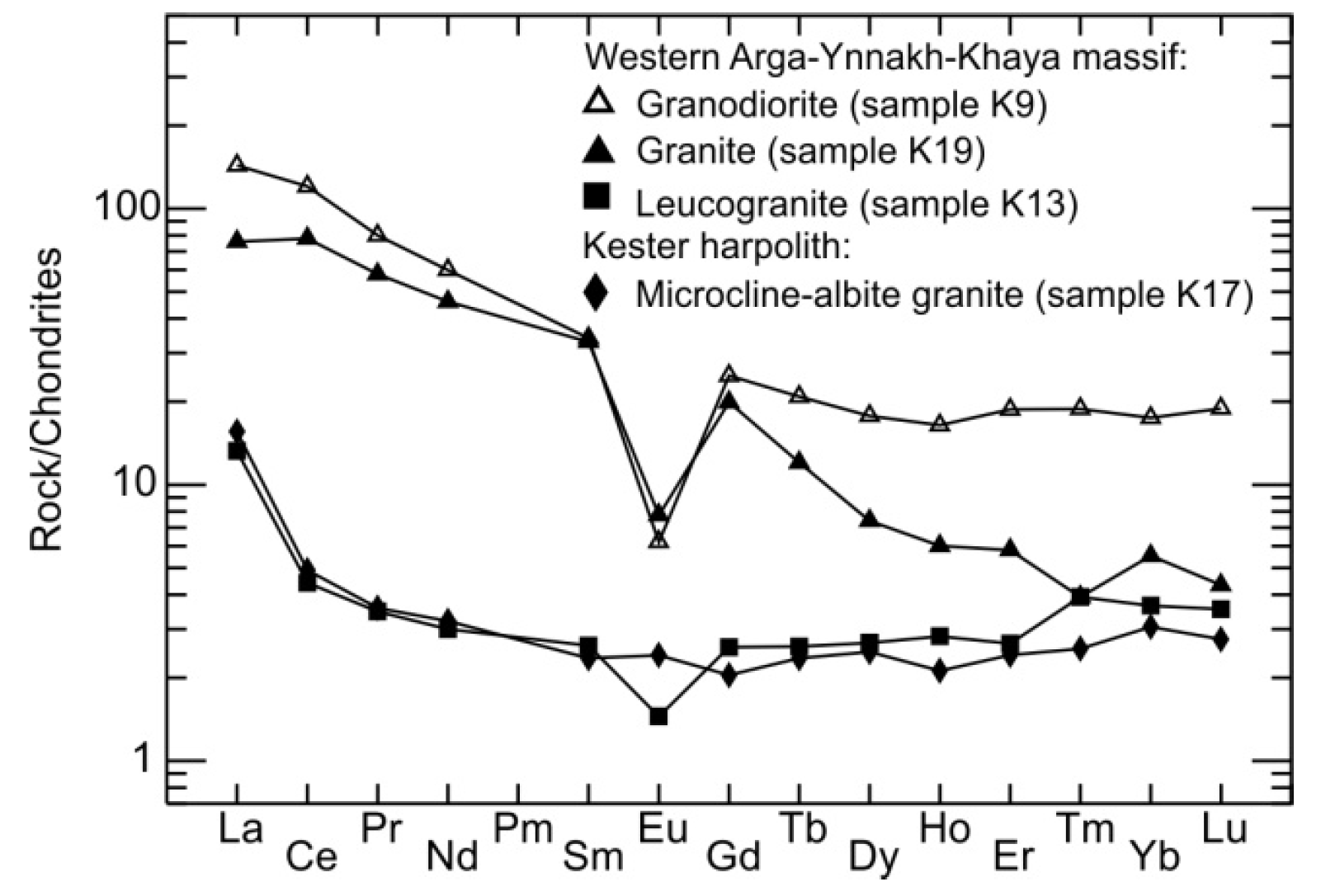
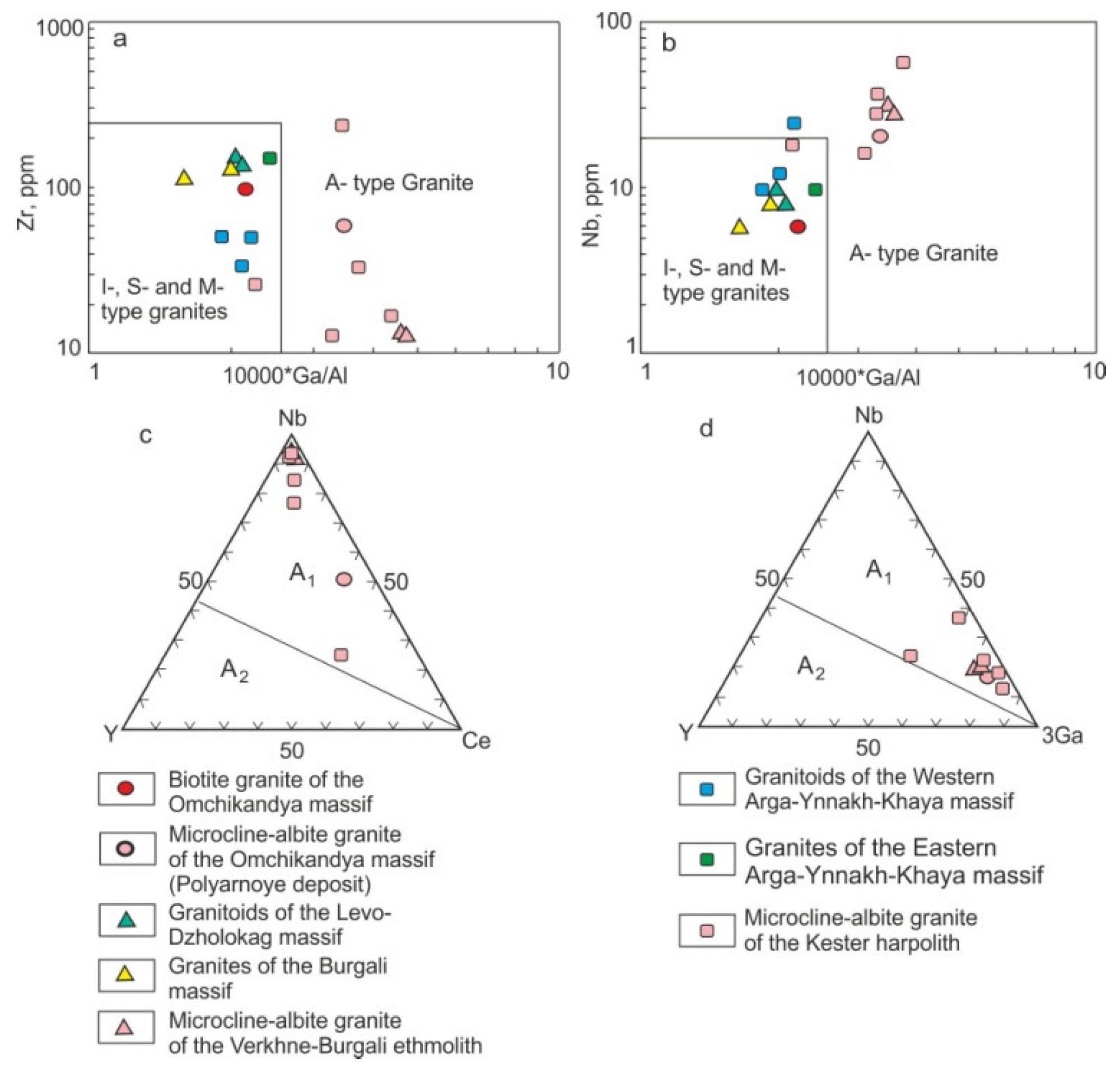
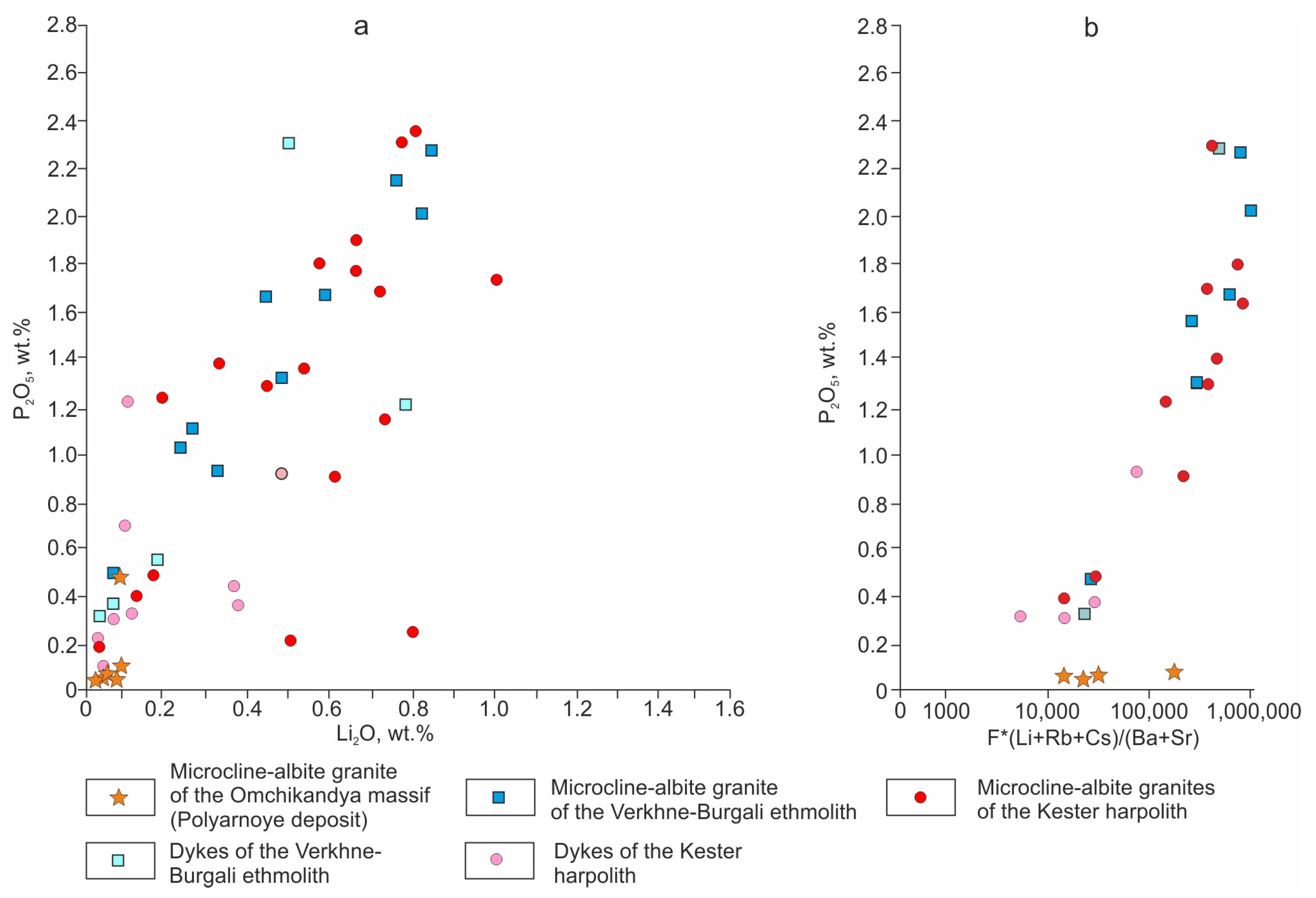
| Massif | Omchikandya (Polyarnoe Deposit) | Verkhne–Burgali Ethmolith | Kester Harpolith | |||||||||
|---|---|---|---|---|---|---|---|---|---|---|---|---|
| Mineral | Eastonite–Siderophyllite | Trilithionite | Polylithionite | Li-Muscovite | Polylithionite | |||||||
| Sample | z1219 | 4/2 * | 258/2 | 238 | 345 | 2544 | 327 | 2491 | 142 * | 141 | 2403/2 | 106 * |
| SiO2 | 35.04 | 42.80 | 43.09 | 49.57 | 45.36 | 49.68 | 45.32 | 45.88 | 142 * | 49.20 | 49.00 | 49.68 |
| TiO2 | 4.24 | 0 | 0 | 0.03 | 0.04 | 0 | 0.15 | 0.29 | 49.20 | 0 | 0.06 | 0 |
| Al2O3 | 11.89 | 24.12 | 23.45 | 22.09 | 36.75 | 23.50 | 21.27 | 30.89 | 0 | 25.60 | 24.54 | 23.50 |
| Fe2O3 | 4.44 | 3.88 | 2.05 | 3.29 | 0.77 | 0 | 5.04 | 1.19 | 25.60 | 0.49 | 2.66 | 0 |
| FeO | 24.31 | 9.89 | 11.52 | 3.95 | 0 | 2.51 | 6.63 | 2.37 | 0.49 | 2.51 | 1.39 | 2.51 |
| MnO | 0.45 | 2.21 | 2.02 | 0.50 | 0.08 | 0.30 | 0.56 | 0.09 | 2.51 | 0.40 | 0.70 | 0.30 |
| MgO | 4.33 | 0.05 | 0.05 | 0 | 0 | 0.54 | 0.10 | 0.44 | 0.40 | 0.34 | 0.10 | 0.54 |
| CaO | 0 | 0.05 | 0.16 | 0.06 | 0.47 | 0.10 | 0 | 0.45 | 0.34 | 0 | 0.10 | 0.10 |
| Na2O | 0.56 | 0.16 | 0.25 | 0.47 | 0.44 | 0.54 | 0.56 | 0.52 | 0 | 0.60 | 0.35 | 0.54 |
| K2O | 8.35 | 9.50 | 9.40 | 10.10 | 10.73 | 9.46 | 9.74 | 10.50 | 0.60 | 9.42 | 9.60 | 9.46 |
| H2O | 3.49 | 1.51 | 1.56 | 0.95 | 3.48 | 1.68 | 1.03 | 3.67 | 9.42 | 2.32 | 1.67 | 1.68 |
| F | 2.41 | 3.51 | 3.78 | 4.09 | 1.68 | 7.00 | 5.45 | 2.73 | 2.32 | 7.00 | 5.11 | 7.00 |
| Cl | - | 0.05 | 0.05 | - | 1.11 | - | 0.80 | - | 7.00 | - | - | - |
| Li2O | 1.28 | 2.07 | 2.30 | 4.04 | 0.32 | 3.31 | 3.26 | 1.05 | 3.31 | 3.31 | 4.07 | 3.31 |
| Rb2O | - | 0.59 | 0.67 | 1.10 | 0.01 | 1.22 | 0.17 | 0.37 | 1.09 | 1.09 | 1.04 | 1.22 |
| Total | 99.51 | 100.39 | 100.36 | 100.21 | 101.24 | 99.84 | 100.08 | 100.96 | 102.28 | 102.28 | 100.64 | 99.84 |
| O=F,Cl | 1.02 | 2.07 | 2.74 | 1.72 | 0.96 | 2.87 | 2.48 | 1.15 | 2.95 | 2.87 | 2.15 | 2.95 |
| f% | 78.6 | 99.4 | 99.4 | 100 | 98.8 | 72.1 | 98.4 | 82.4 | 85.7 | 85.7 | 95.9 | 721 |
| al,% | 17.7 | 34.4 | 24.5 | 31.8 | 48.2 | 32.1 | 31.4 | 42.3 | 32.6 | 32.6 | 35.4 | 32.1 |
| Sample | 2004/1 | 602/1 | 602/2 | 2005/1 | 603/2 | 600/1 | K-9 | K-13 | K-19 |
|---|---|---|---|---|---|---|---|---|---|
| No. | 1 | 2 | 3 | 4 | 5 | 6 | 7 | 8 | 9 |
| Elements, ppm | |||||||||
| Li | 25.2 | 39.7 | 64.4 | 35 | 10 | 467 | 112 | 107.3 | 74.7 |
| Cs | 20 | 10 | 14.3 | 36 | 23 | 200 | - | - | - |
| F | 500 | 800 | 1000 | 800 | 100 | 11,400 | 8500 | 3900 | 1200 |
| P | 459 | 561 | 408 | 408 | 51 | 2550 | 1530 | 2091 | 2240 |
| Be | 1.71 | 2.14 | 2.27 | 3.45 | 1.09 | 1.35 | 3.46 | 5.3 | 3.99 |
| Ti | 3005 | 2566 | 3282 | 2426 | 57 | 89 | 11,188 | 276 | 2368 |
| V | 32 | 22 | 40 | 19 | 2.17 | 0.61 | 5.2 | 0.88 | 18 |
| Cr | 41 | 11.3 | 25 | 29 | 4.98 | 4.73 | 7 | 11.2 | 170 |
| Mn | 654 | 552 | 751 | 534 | 115 | 626 | 255 | 109 | 338 |
| Co | 9.7 | 7.5 | 11.3 | 6.7 | 1.53 | 0.18 | 2.45 | 0.74 | 2.96 |
| Ni | 14.6 | 8.2 | 10.1 | 16 | 7 | 5.6 | 6.9 | 10.6 | 14.5 |
| Cu | 23 | 9.6 | 11.7 | 7.3 | 6.3 | 7.5 | 10.6 | 21 | 6.5 |
| Zn | 49 | 35 | 71 | 37 | 0.13 | 75 | 28 | 4.4 | 11.7 |
| Ga | 17 | 19 | 19 | 18 | 13.8 | 38 | 21 | 14.9 | 20 |
| Ge | 1.59 | 1.57 | 1.63 | 1.97 | 1.67 | 3.39 | 1.74 | 3.22 | 1.64 |
| Rb | 87 | 76 | 78 | 95 | 89 | 1629 | 201 | 412 | 215 |
| Sr | 145 | 169 | 127 | 139 | 78 | 29 | 72 | 43 | 83 |
| Y | 21 | 17 | 27 | 21 | 12.3 | 0.67 | 24 | 3.75 | 8.5 |
| Zr | 166 | 183 | 174 | 177 | 119 | 12 | 265 | 29 | 152 |
| Nb | 8.8 | 7.2 | 9.2 | 8.3 | 5.8 | 32 | 19 | 13.1 | 11.1 |
| Mo | 1 | 1.01 | 0.55 | 0.48 | 0.6 | 0.46 | 1.12 | 1.38 | 0.81 |
| Sn | 2.18 | 1.32 | 3.52 | 1.15 | 1.41 | 79 | 4.45 | 12.6 | 7 |
| Sb | 1.13 | 2.17 | 1.48 | 0.9 | 6.4 | 5.4 | 0.42 | 0.37 | 0.25 |
| Ba | 615 | 629 | 384 | 698 | 646 | 140 | 482 | 133 | 375 |
| Hf | 4.4 | 4.57 | 4.14 | 4.63 | 3.71 | 1.02 | 7.9 | 1.29 | 3.9 |
| Ta | 0.72 | 0.57 | 0.74 | 0.61 | 0.6 | 96.7 | 2.19 | 4.92 | 1.11 |
| W | 0.64 | 0.34 | 0.6 | 0.82 | 0.89 | 9.6 | 1.47 | 64 | 4.17 |
| Pb | 13.1 | 11.1 | 9 | 9.9 | 25 | 0.61 | 21 | 17 | 19 |
| Th | 8.1 | 9 | 6.1 | 10.3 | 18 | 0.21 | 20 | 0.92 | 14.7 |
| U | 2.53 | 1.74 | 2.48 | 1.75 | 3.21 | 8.9 | 4.06 | 15 | 4.62 |
| Sample | K-6 | K-10 | K-1 | K-2 | K-14 | K-8 | K-21 | K-5 | |
| No. | 10 | 11 | 12 | 13 | 14 | 15 | 16 | 17 | |
| Element, ppm | |||||||||
| Li | 261.3 | 438.7 | 1139 | 2375 | 653.3 | 5376 | 840 | 4766 | |
| Cs | - | - | - | - | - | - | - | - | |
| F | 6000 | 4100 | 8200 | 8200 | 8000 | 16,400 | 6500 | 9200 | |
| P | 1887 | 6222 | 8058 | 8058 | 6579 | 7089 | 1683 | 8823 | |
| Be | 1.2 | 1.63 | 0.64 | 0.58 | 1.15 | 3.18 | 1.15 | 0.64 | |
| Ti | 703 | 27 | 95 | 67 | 71 | 8029 | 124 | 112 | |
| V | - | - | - | - | - | 177 | 1.16 | - | |
| Cr | 531 | 70 | 284 | 66 | 110 | 358 | 115 | 303 | |
| Mn | 226 | 274 | 499 | 497 | 284 | 605 | 459 | 411 | |
| Co | 1.28 | 0.31 | 1.3 | 1.05 | 0.45 | 17 | 0.53 | 0.64 | |
| Ni | 28 | 7.2 | 13 | 9.2 | 12.9 | 53 | 7.6 | 14.4 | |
| Cu | 16 | 4.83 | 24 | 17 | 8.9 | 50 | 5.7 | 13.3 | |
| Zn | 24 | 22 | 92 | 88 | 41 | 159 | 25 | 85 | |
| Ga | 13.8 | 32 | 40 | 39 | 36 | 26 | 29 | 38 | |
| Ge | 3.45 | 7.2 | 3.12 | 5.3 | 6 | 2.87 | 5.1 | 9.3 | |
| Rb | 334 | 2935 | 1496 | 1689 | 1539 | 1408 | 985 | 1651 | |
| Sr | 85 | 56 | 8.5 | 7 | 77 | 67 | 20 | 4.42 | |
| Y | 2.89 | 1.76 | 0.06 | - | 0.52 | 23 | 0.58 | 0.054 | |
| Zr | 54 | 10.2 | 27 | 24 | 18 | 214 | 21 | 19 | |
| Nb | 10 | 19 | 75 | 113 | 30 | 37 | 57 | 70 | |
| Mo | 2.35 | 0.6 | 0.49 | 0.41 | 1.02 | 2.03 | 1.22 | 1.27 | |
| Sn | 92 | 35 | 948 | 568 | 14 | 90 | 93 | 352 | |
| Sb | 0.15 | 0.12 | 1.11 | 0.21 | 0.35 | 5.9 | 0.44 | 0.5 | |
| Ba | 302 | 8.5 | 6.6 | 62 | 26 | 399 | 71 | 1.43 | |
| Hf | 1.8 | 0.4 | 2.95 | 3.12 | 1.31 | 5.45 | 1.78 | 2.23 | |
| Ta | 2.62 | 4.09 | 61 | 102 | 30 | 6 | 43 | 51 | |
| W | 15 | 10.6 | 24 | 36 | 17 | 7 | 11 | 18 | |
| Pb | 4.99 | 3.13 | 4.21 | 1.54 | 2.5 | 10.8 | 4.15 | 1.67 | |
| Th | 2.34 | 0.06 | 0.22 | 0.096 | 0.16 | 14.2 | 0.33 | 0.21 | |
| U | 1.04 | 6.3 | 7.7 | 10.3 | 11.3 | 6.3 | 2.87 | 18 | |
Disclaimer/Publisher’s Note: The statements, opinions and data contained in all publications are solely those of the individual author(s) and contributor(s) and not of MDPI and/or the editor(s). MDPI and/or the editor(s) disclaim responsibility for any injury to people or property resulting from any ideas, methods, instructions or products referred to in the content. |
© 2024 by the authors. Licensee MDPI, Basel, Switzerland. This article is an open access article distributed under the terms and conditions of the Creative Commons Attribution (CC BY) license (https://creativecommons.org/licenses/by/4.0/).
Share and Cite
Trunilina, V.A.; Prokopiev, A.V. Aptian Li-F Granites of the Northern Verkhoyansk–Kolyma Orogenic Belt, Eastern Russia: Composition, Genesis, and Ore Potential. Minerals 2024, 14, 173. https://doi.org/10.3390/min14020173
Trunilina VA, Prokopiev AV. Aptian Li-F Granites of the Northern Verkhoyansk–Kolyma Orogenic Belt, Eastern Russia: Composition, Genesis, and Ore Potential. Minerals. 2024; 14(2):173. https://doi.org/10.3390/min14020173
Chicago/Turabian StyleTrunilina, Vera A., and Andrei V. Prokopiev. 2024. "Aptian Li-F Granites of the Northern Verkhoyansk–Kolyma Orogenic Belt, Eastern Russia: Composition, Genesis, and Ore Potential" Minerals 14, no. 2: 173. https://doi.org/10.3390/min14020173
APA StyleTrunilina, V. A., & Prokopiev, A. V. (2024). Aptian Li-F Granites of the Northern Verkhoyansk–Kolyma Orogenic Belt, Eastern Russia: Composition, Genesis, and Ore Potential. Minerals, 14(2), 173. https://doi.org/10.3390/min14020173






